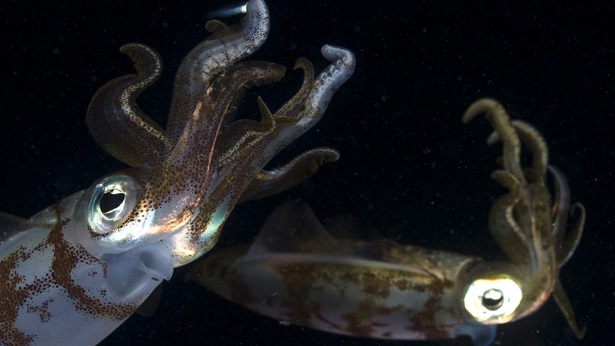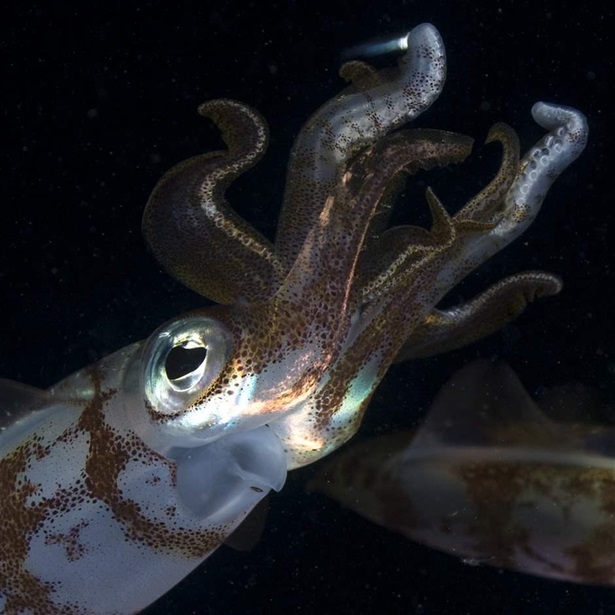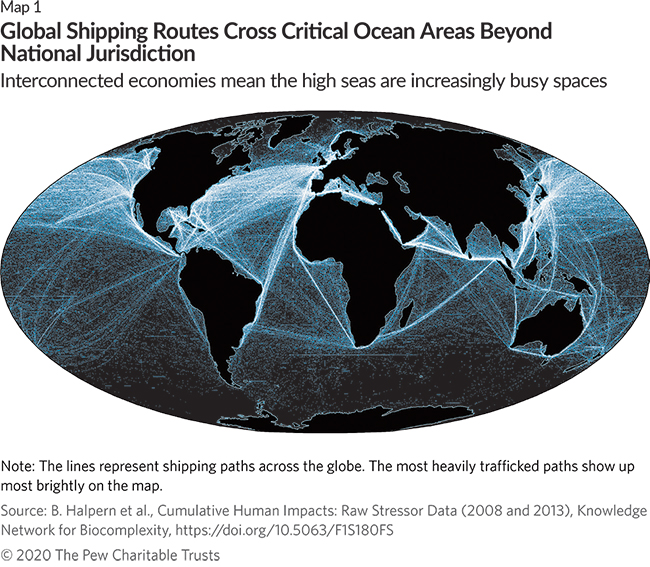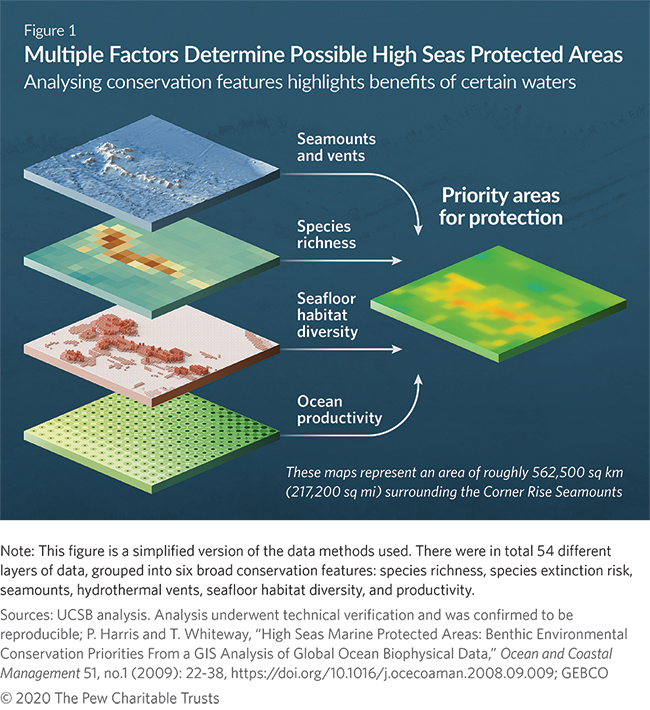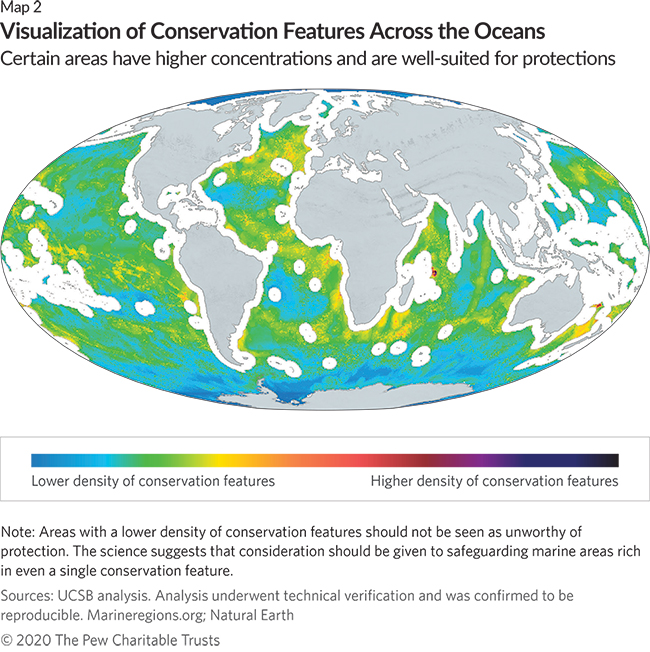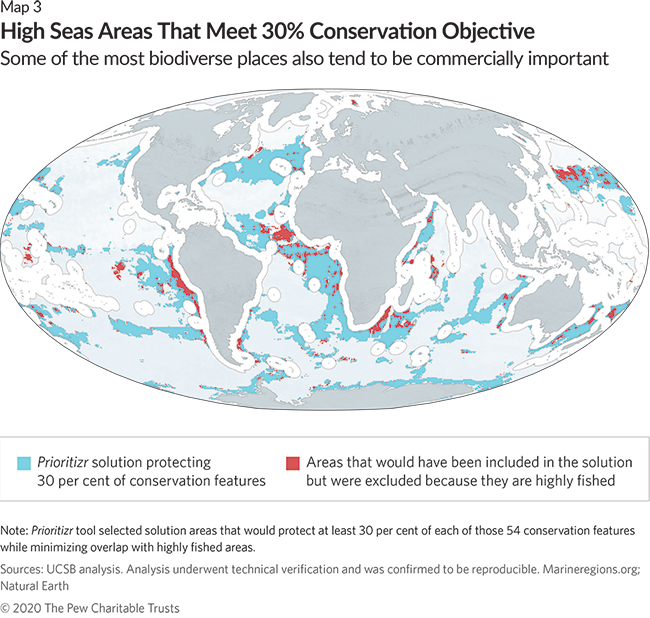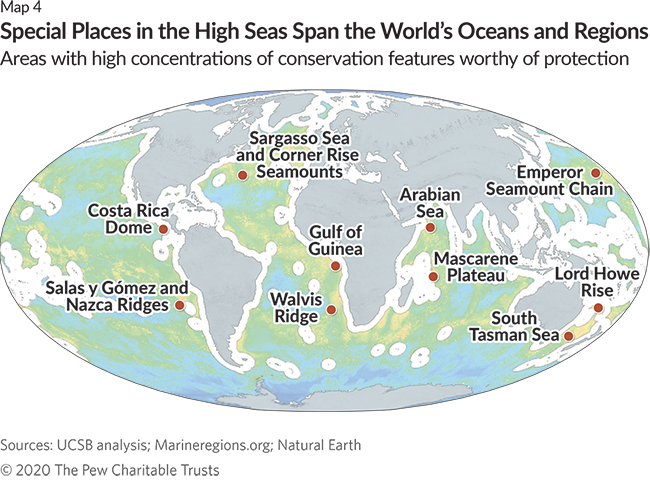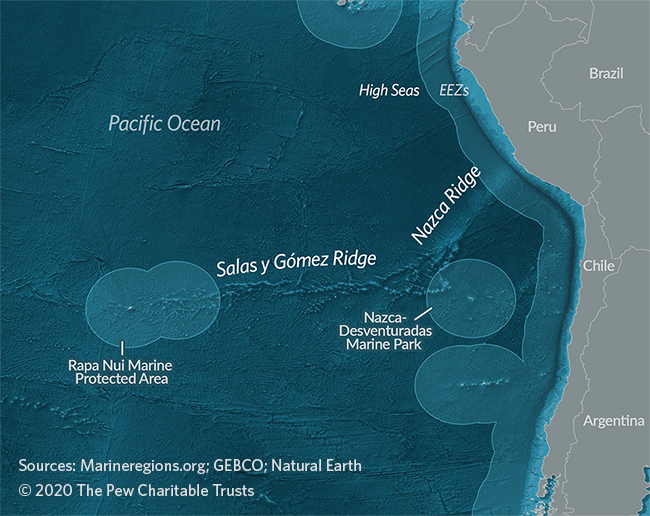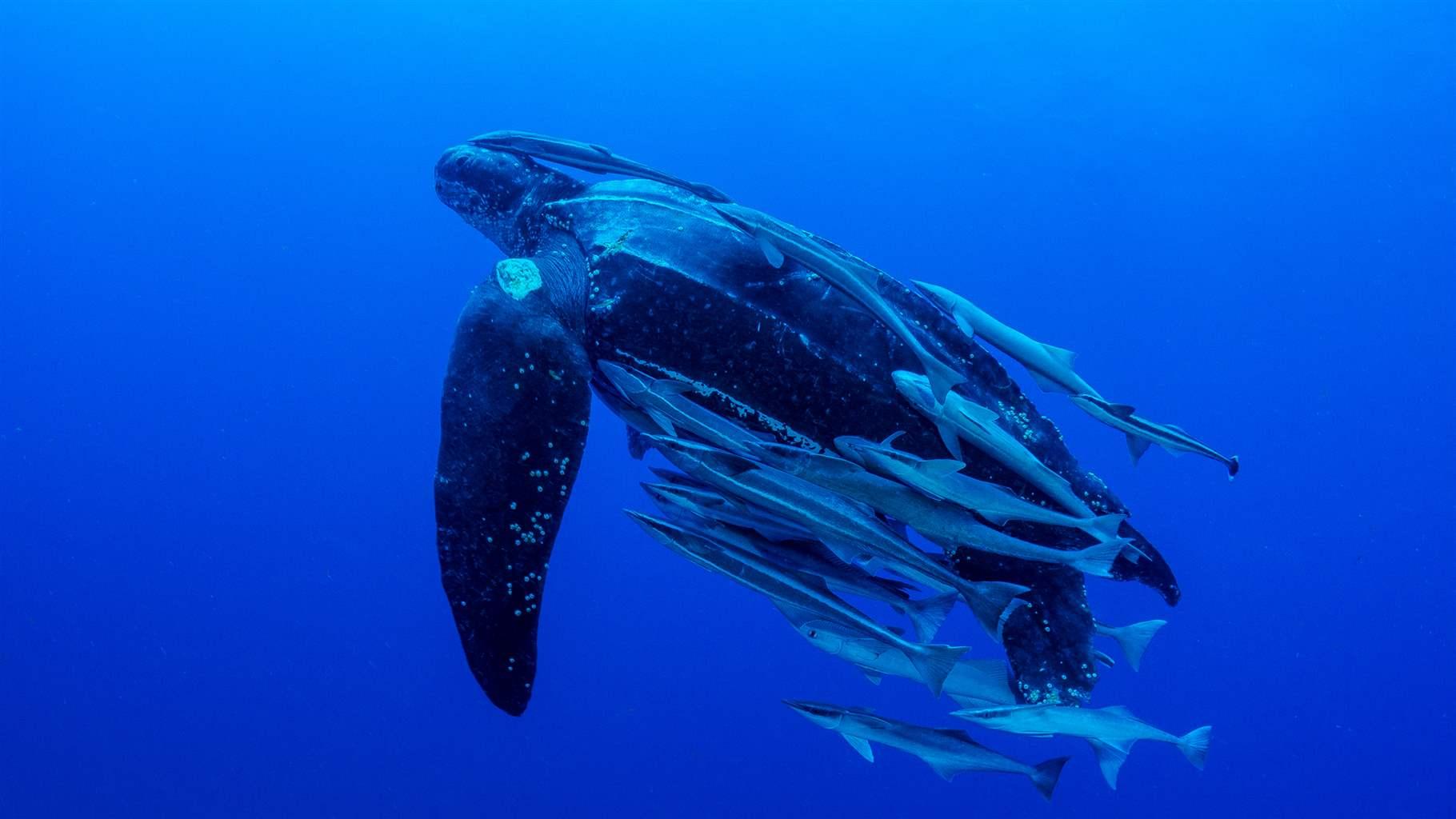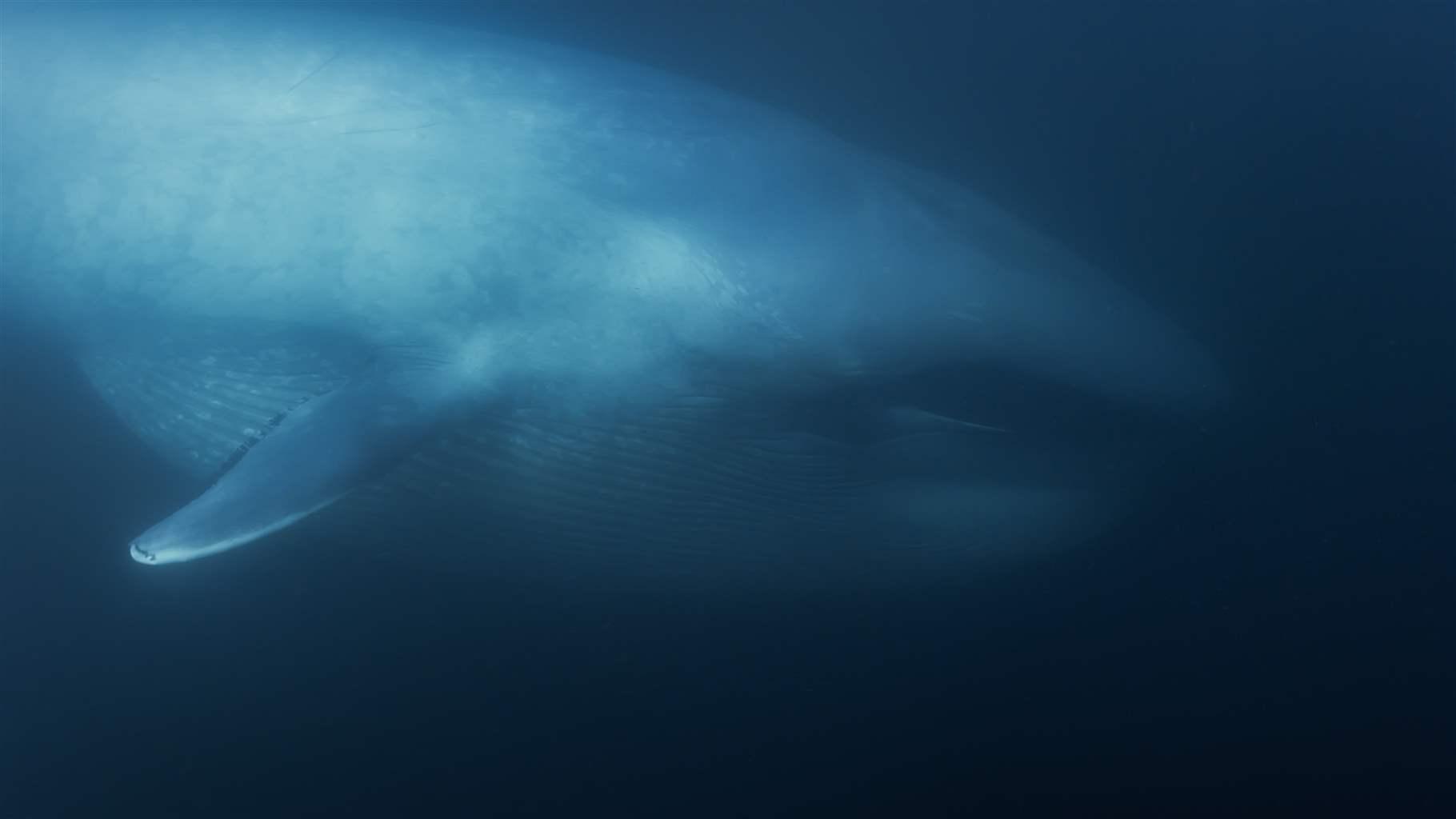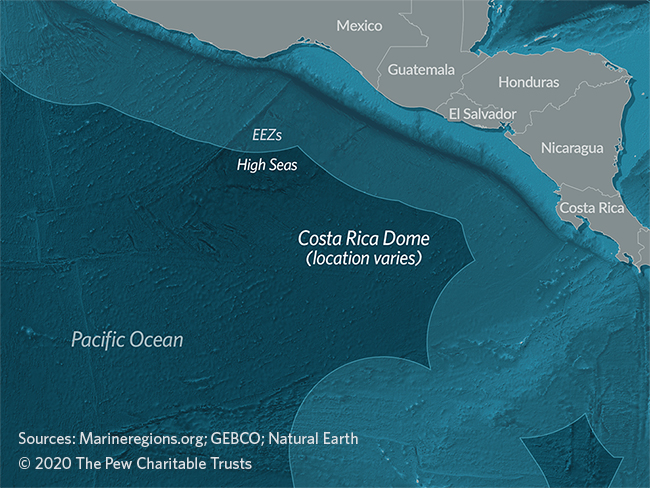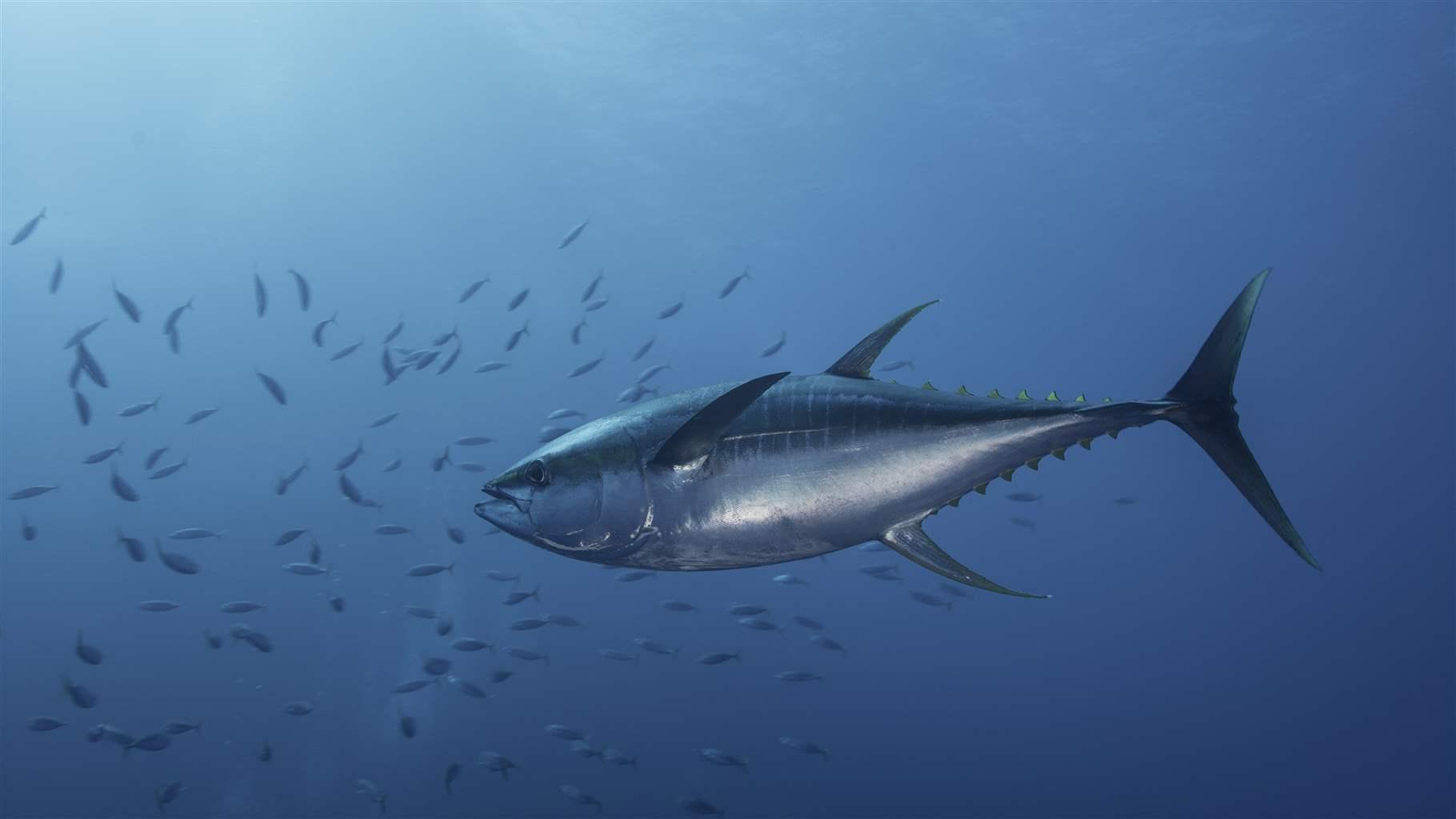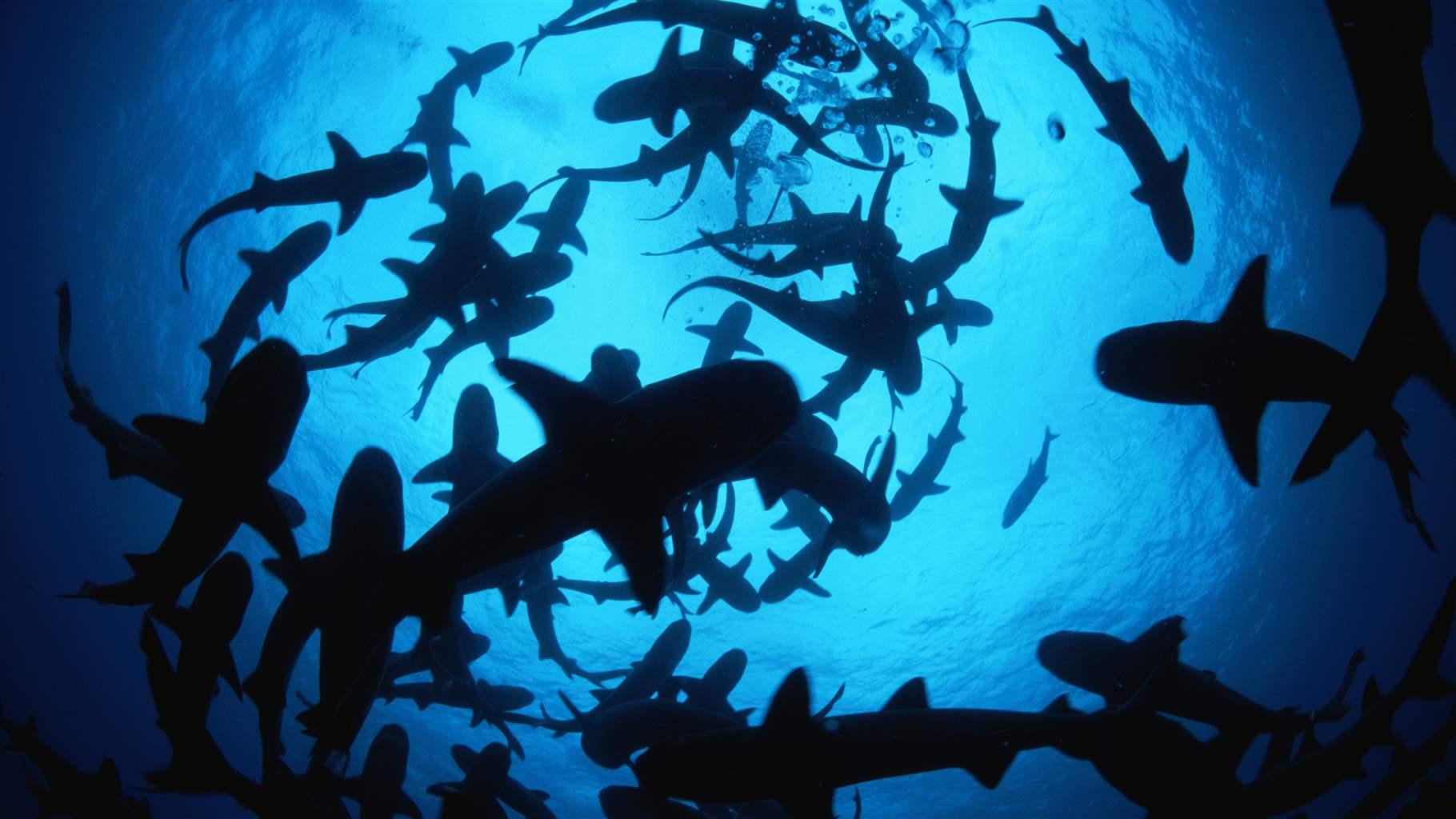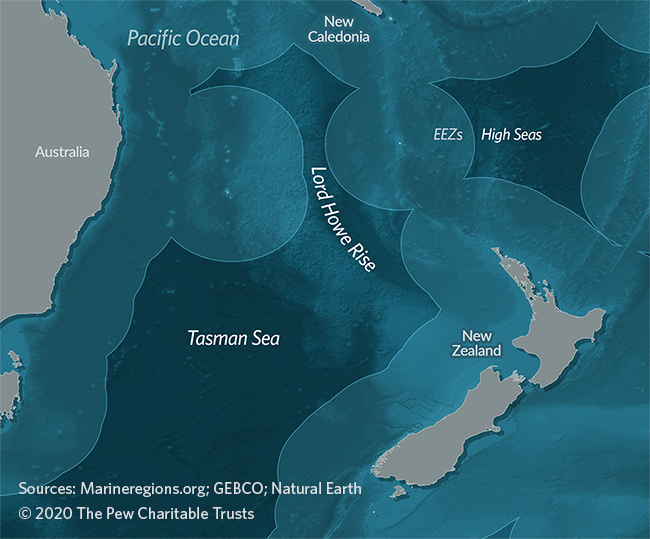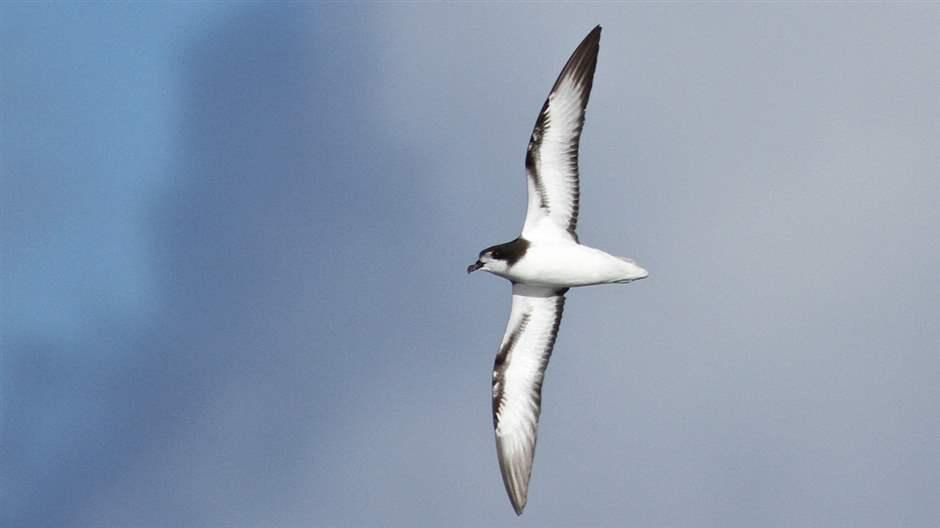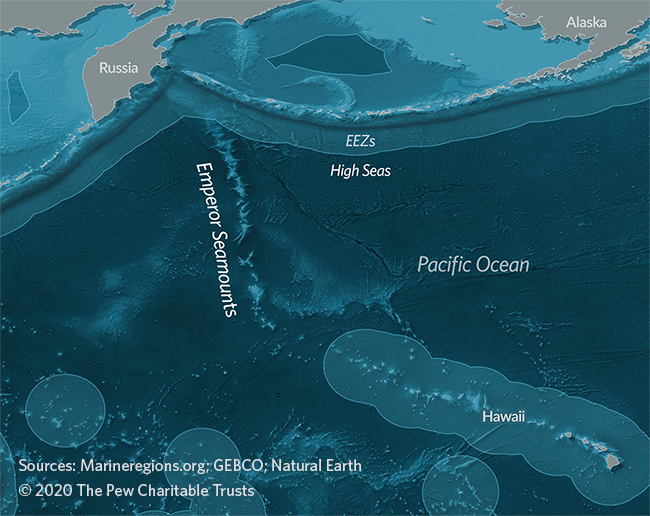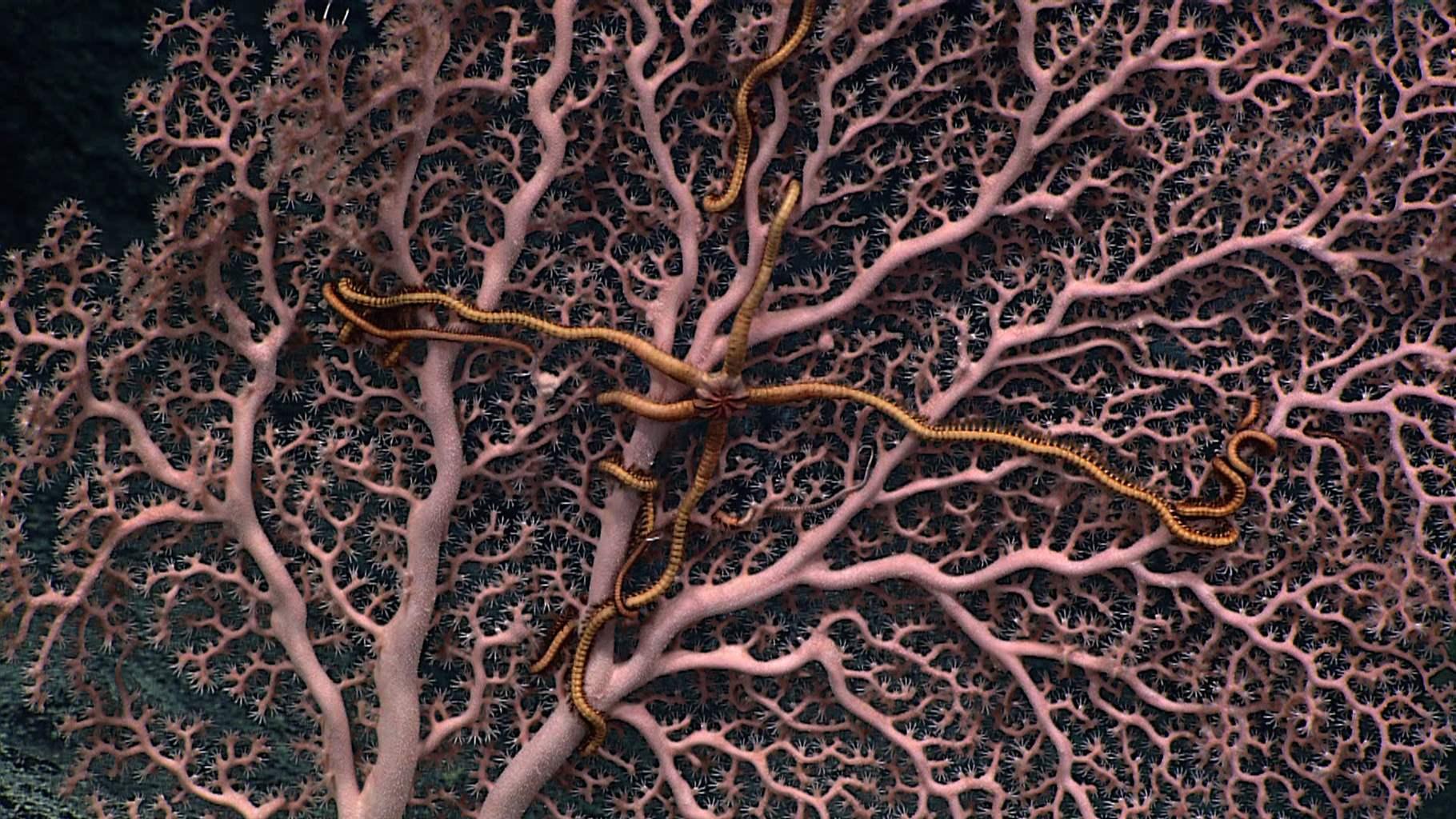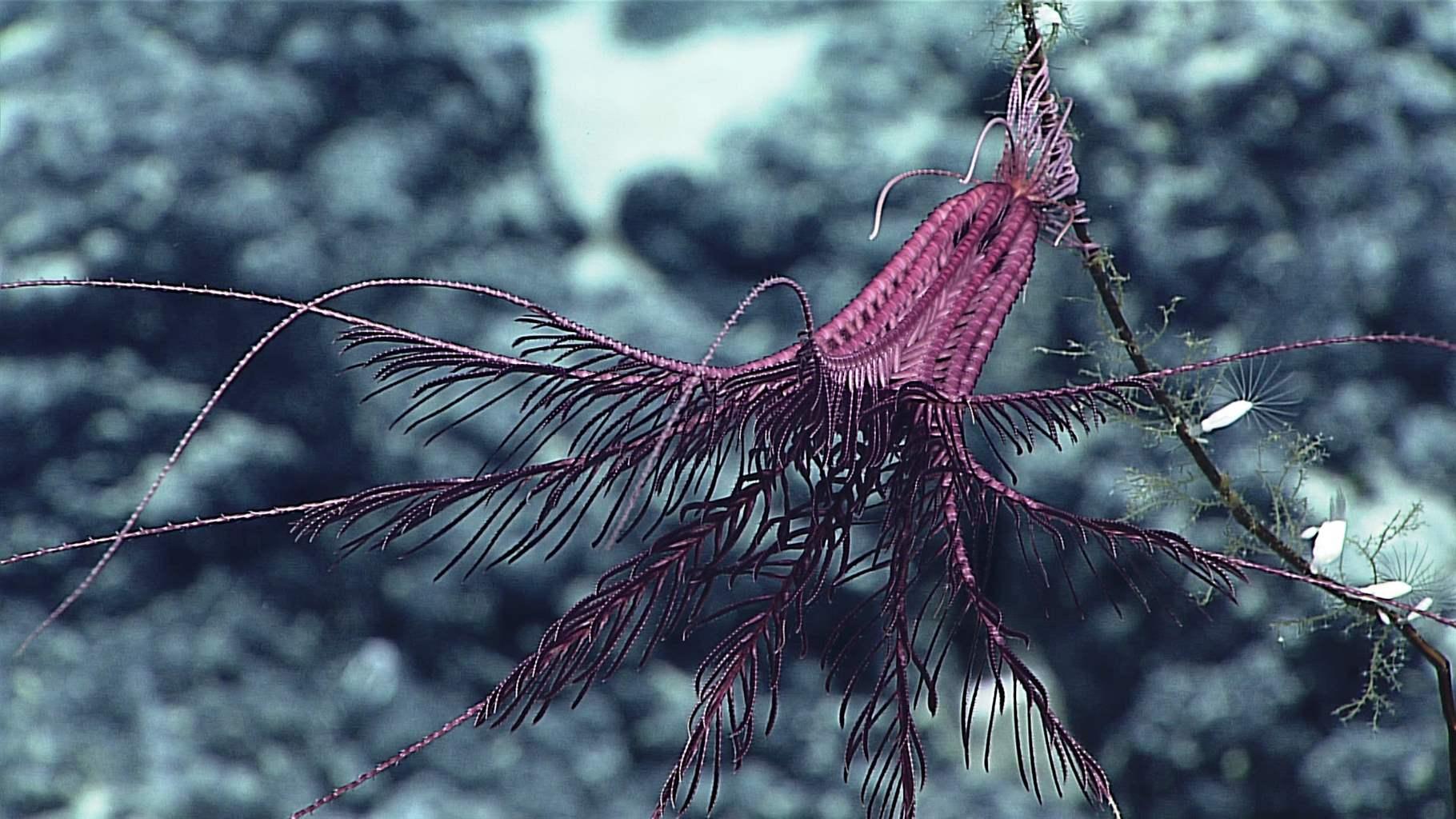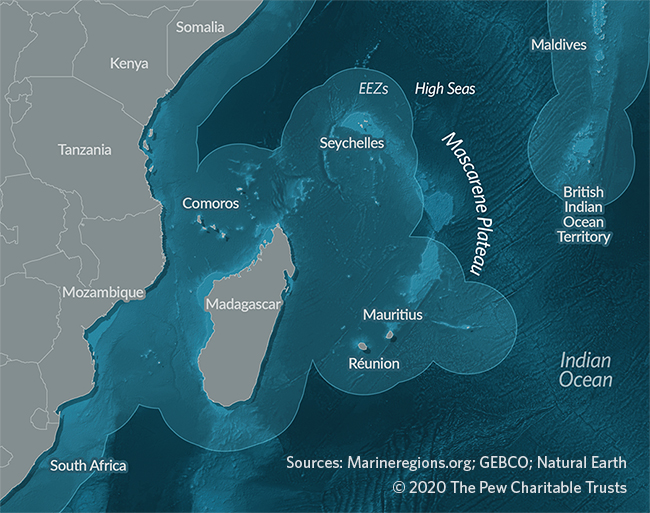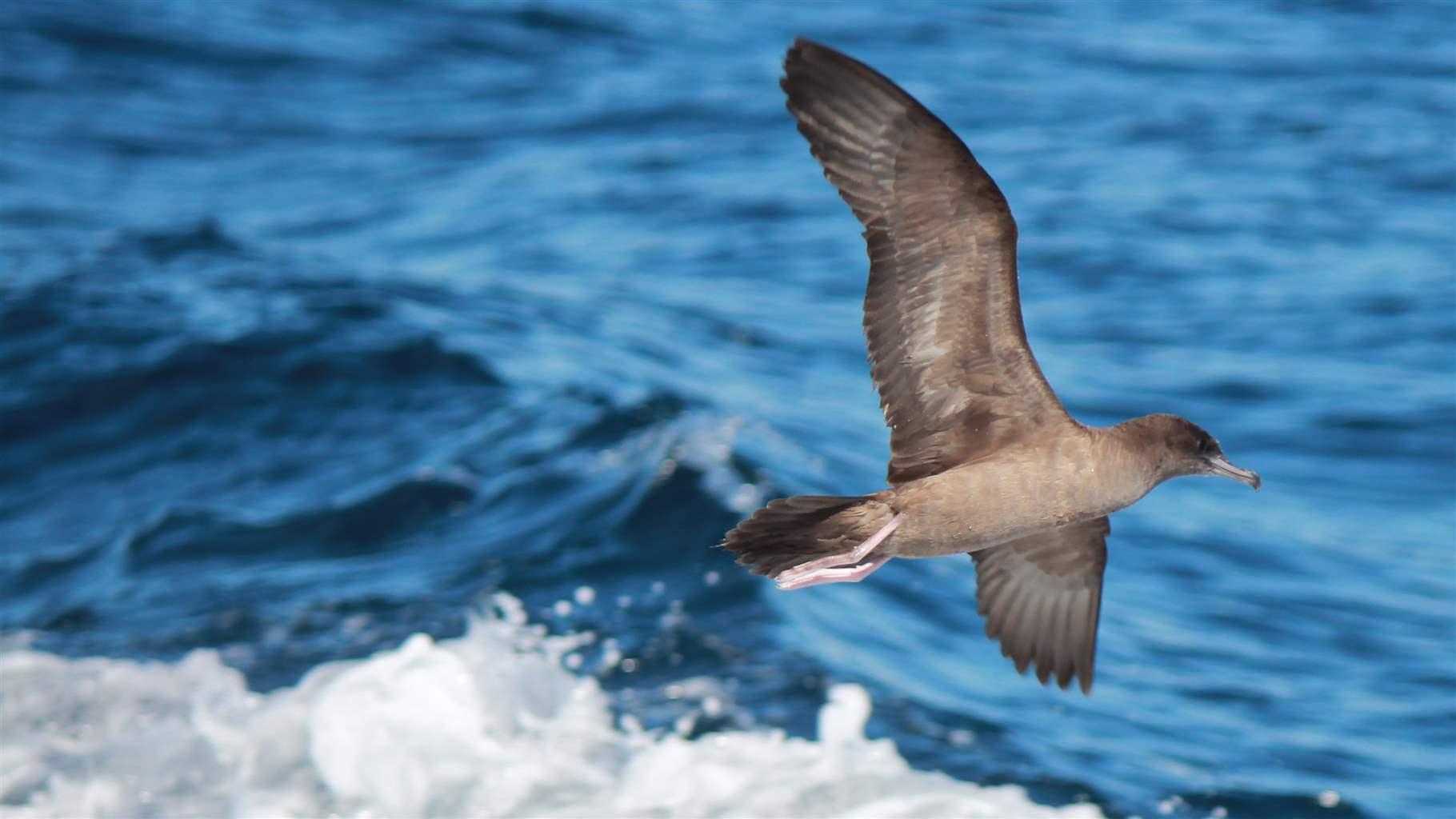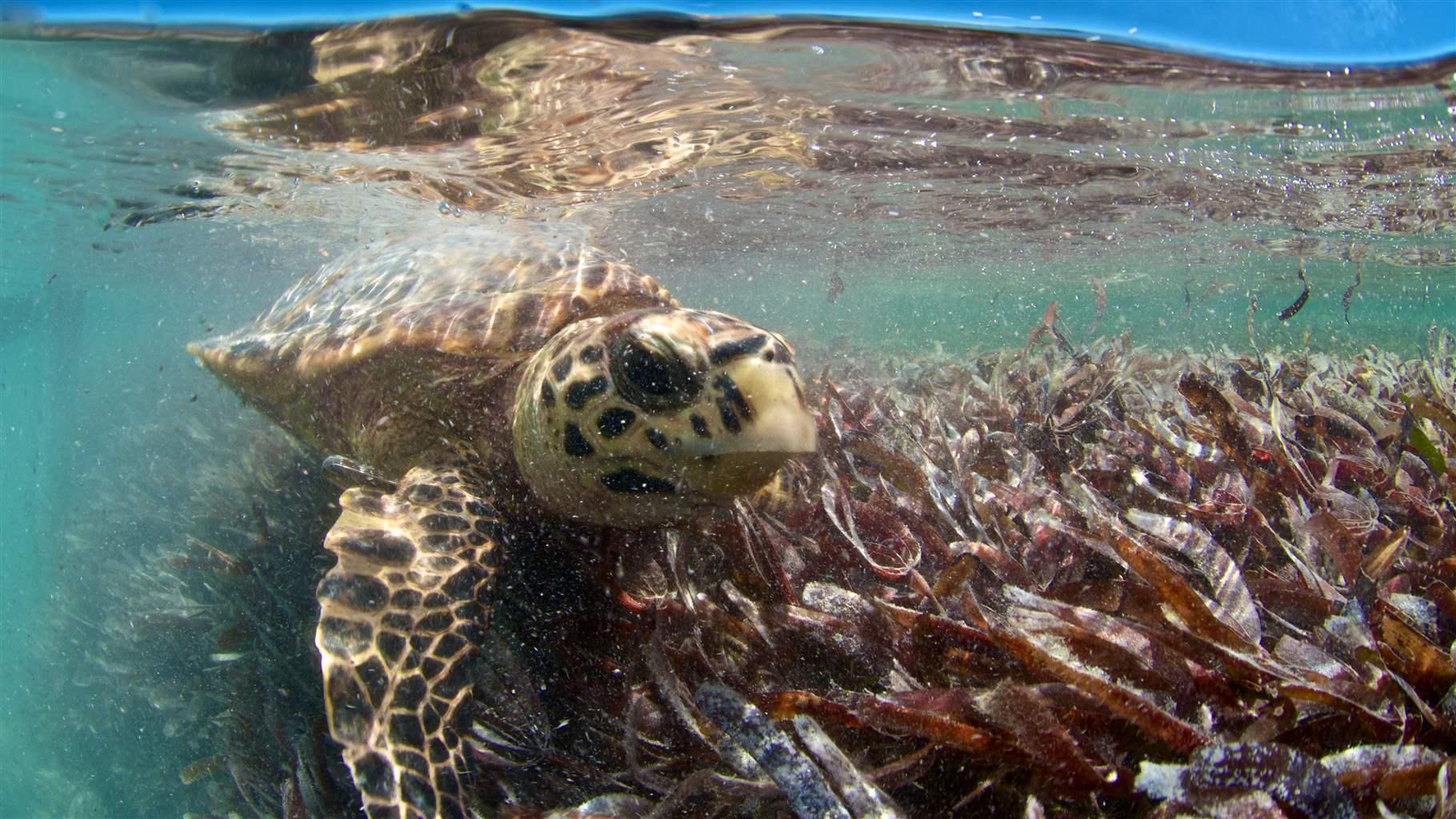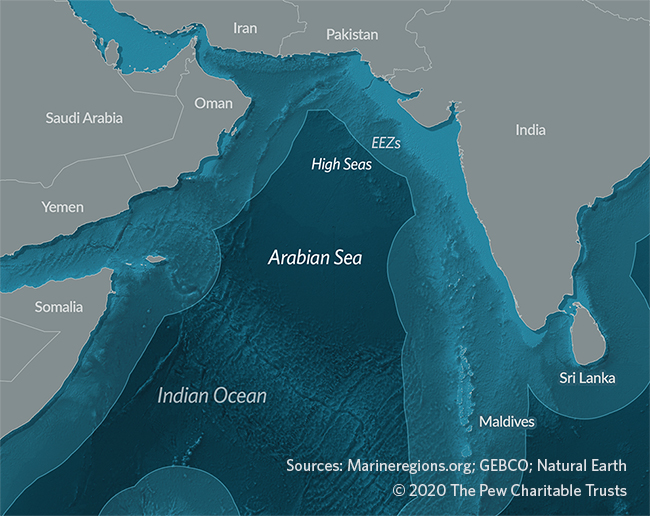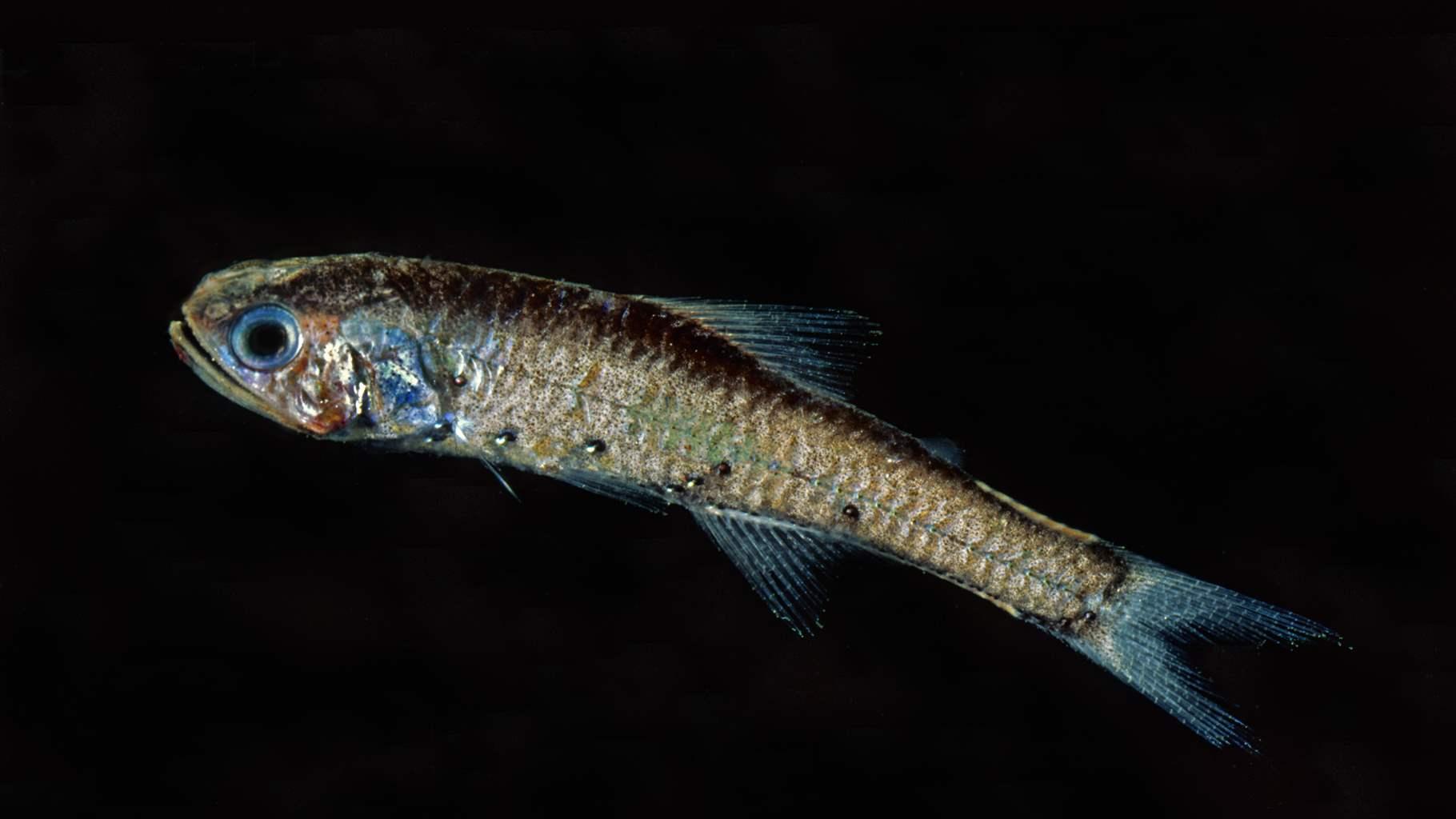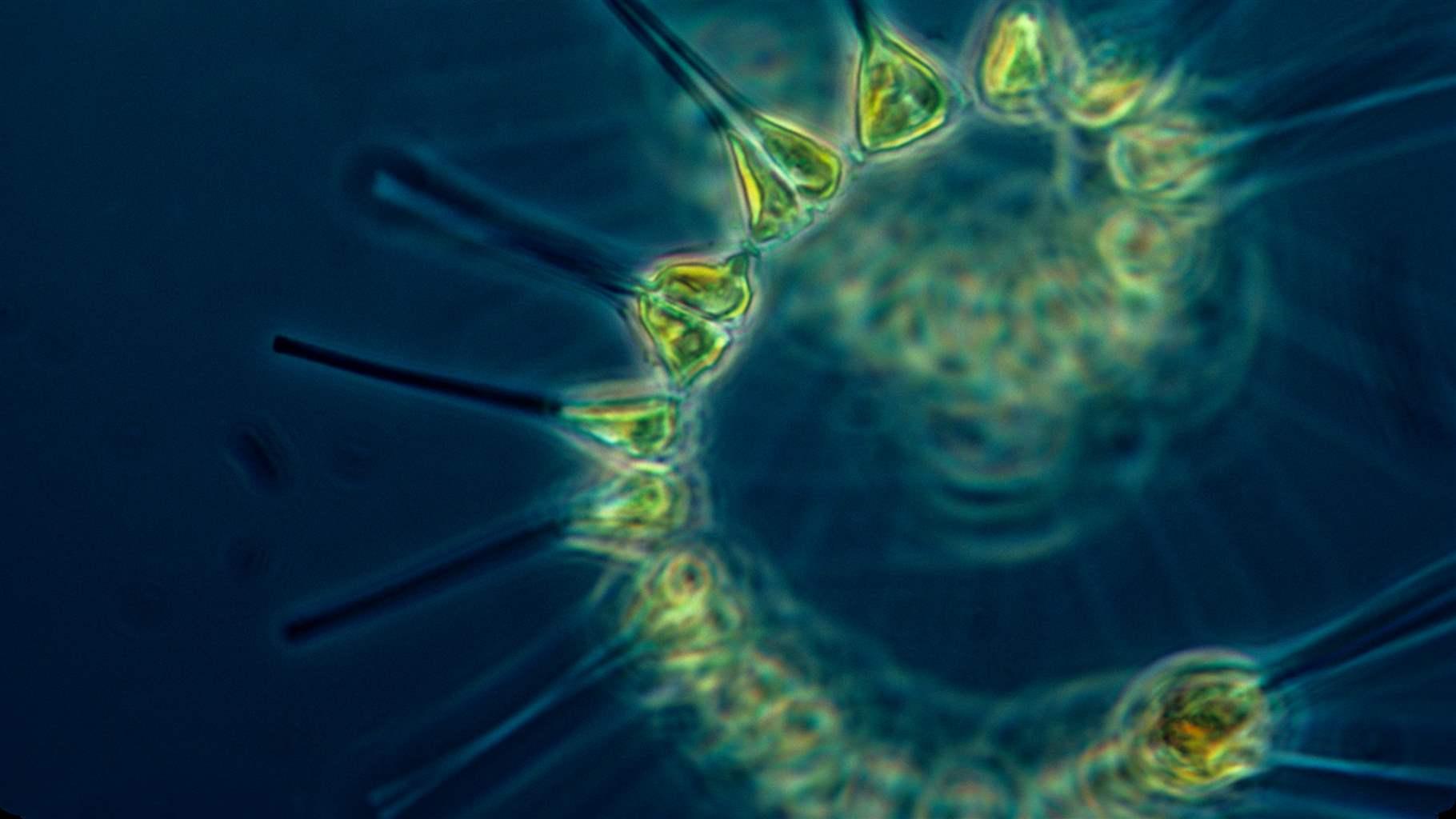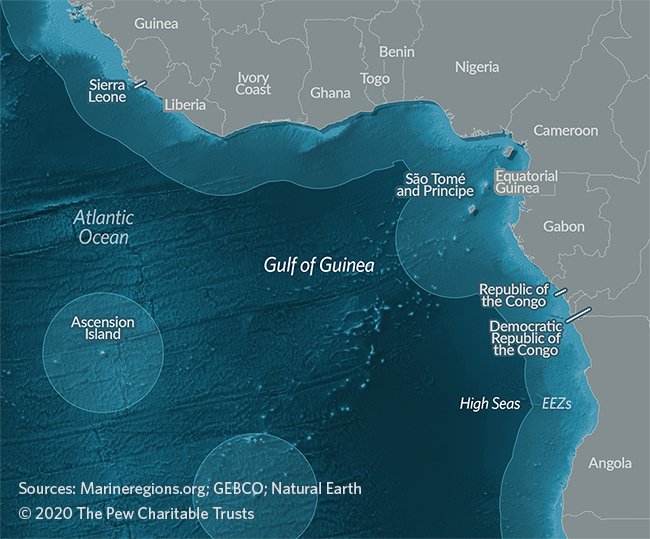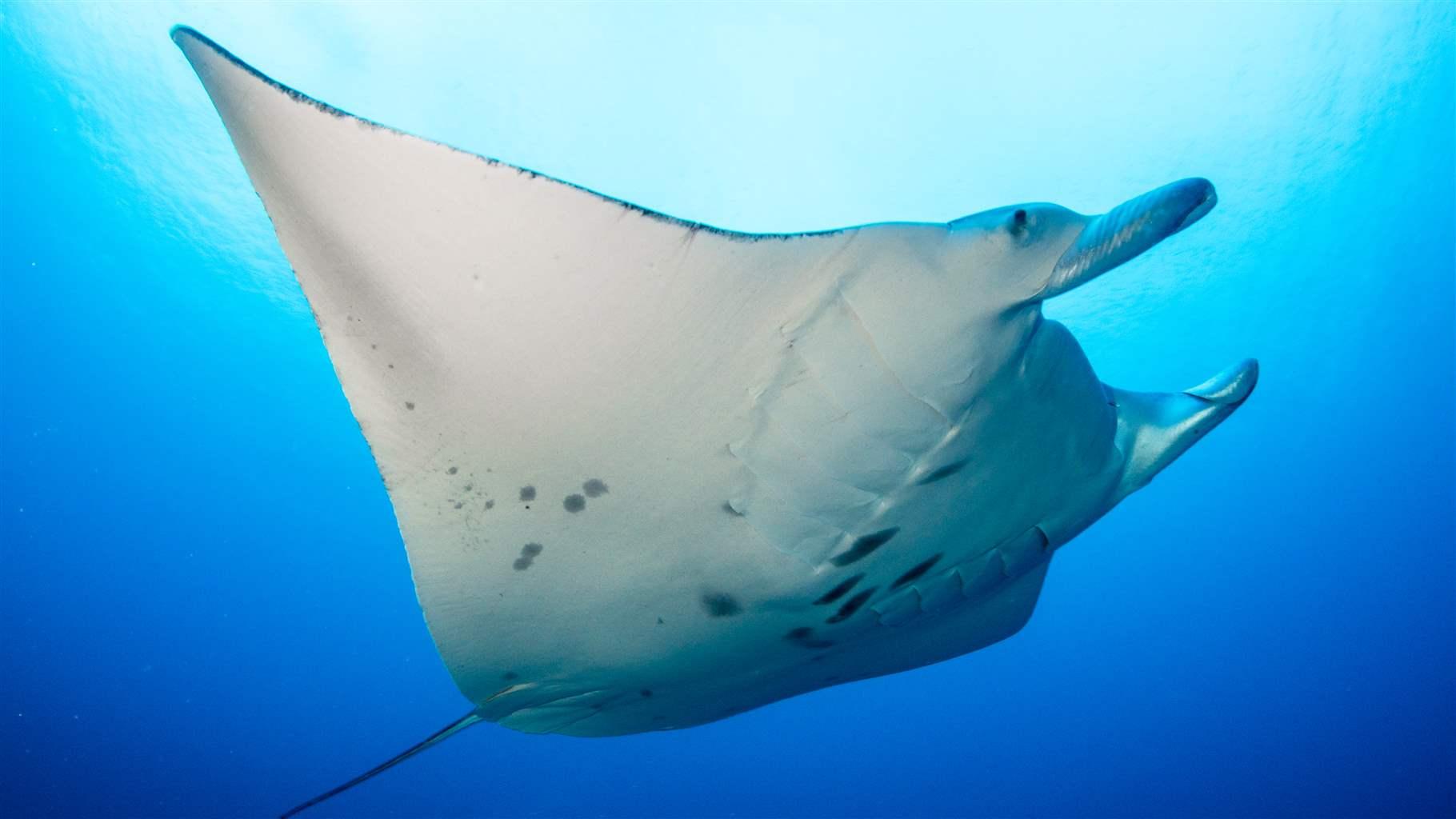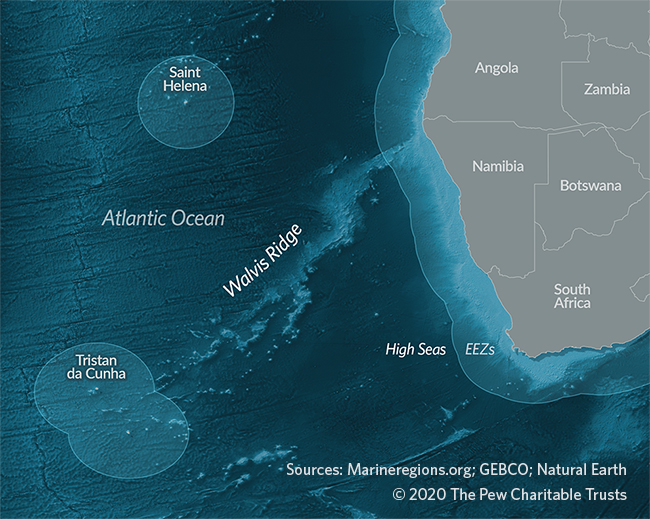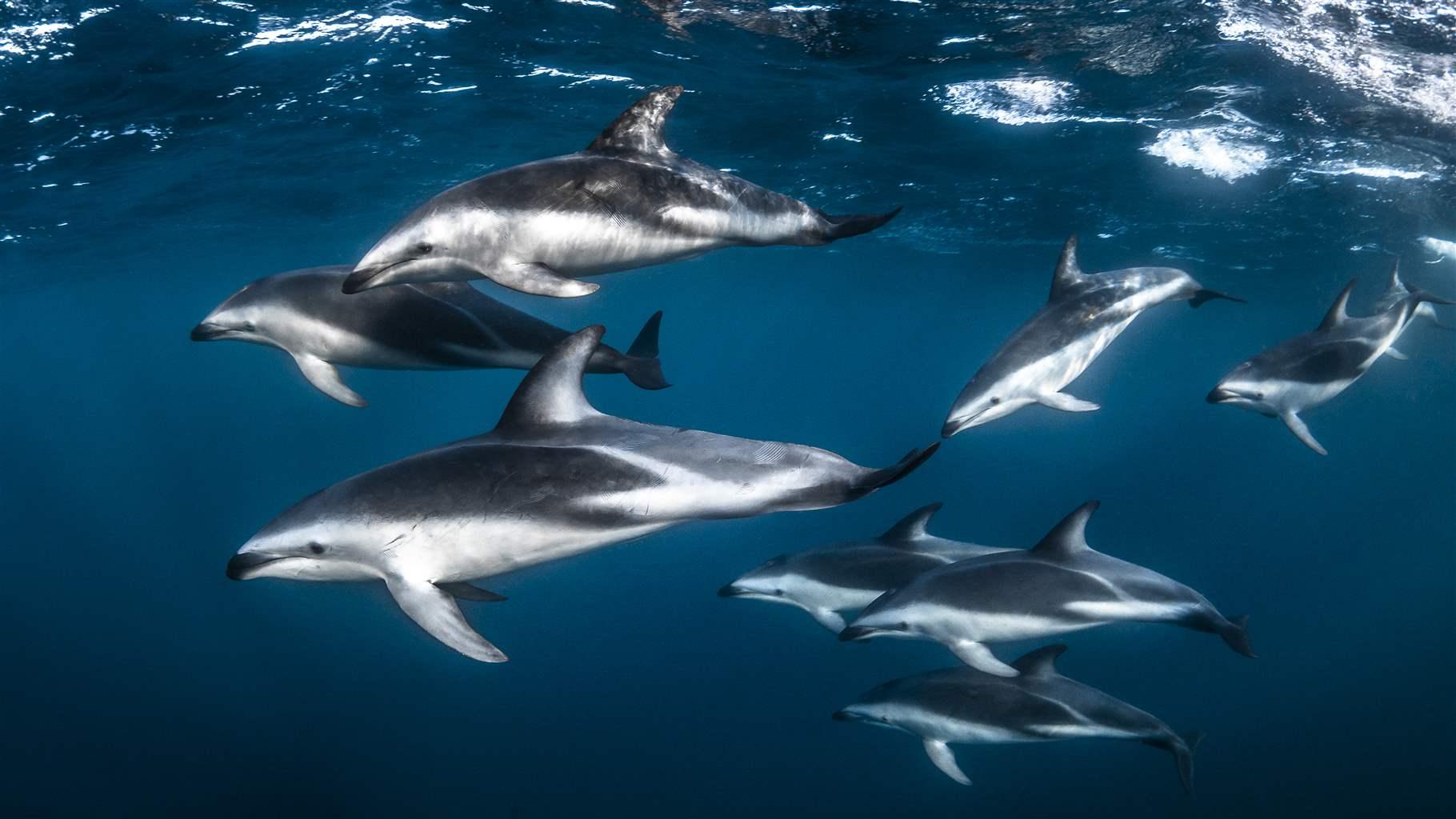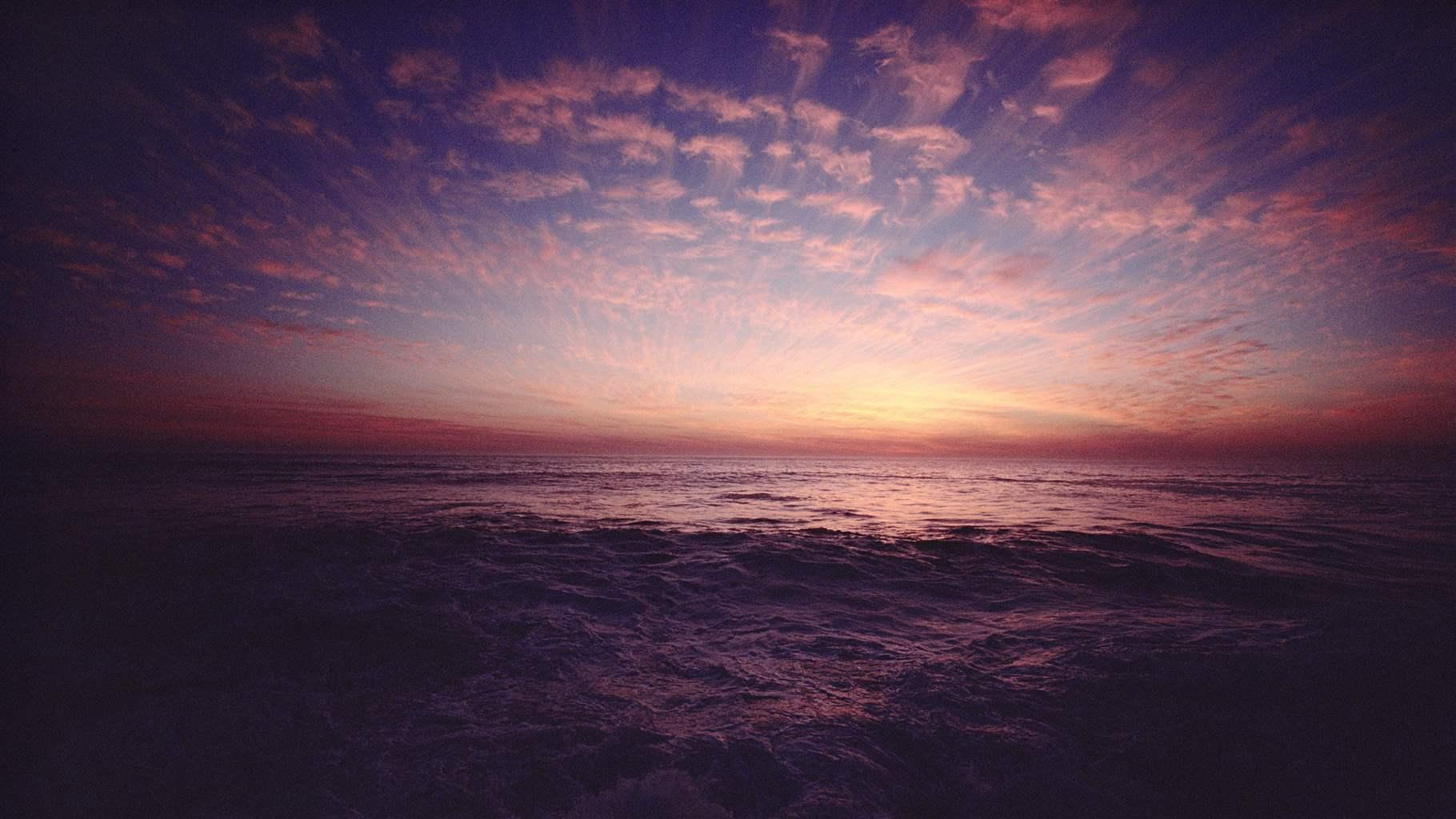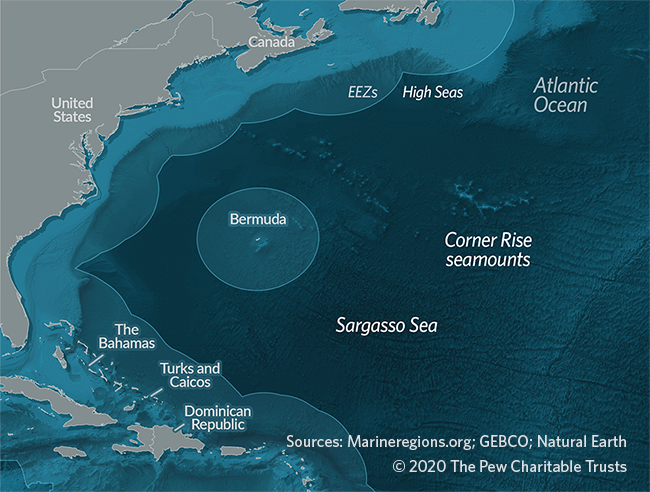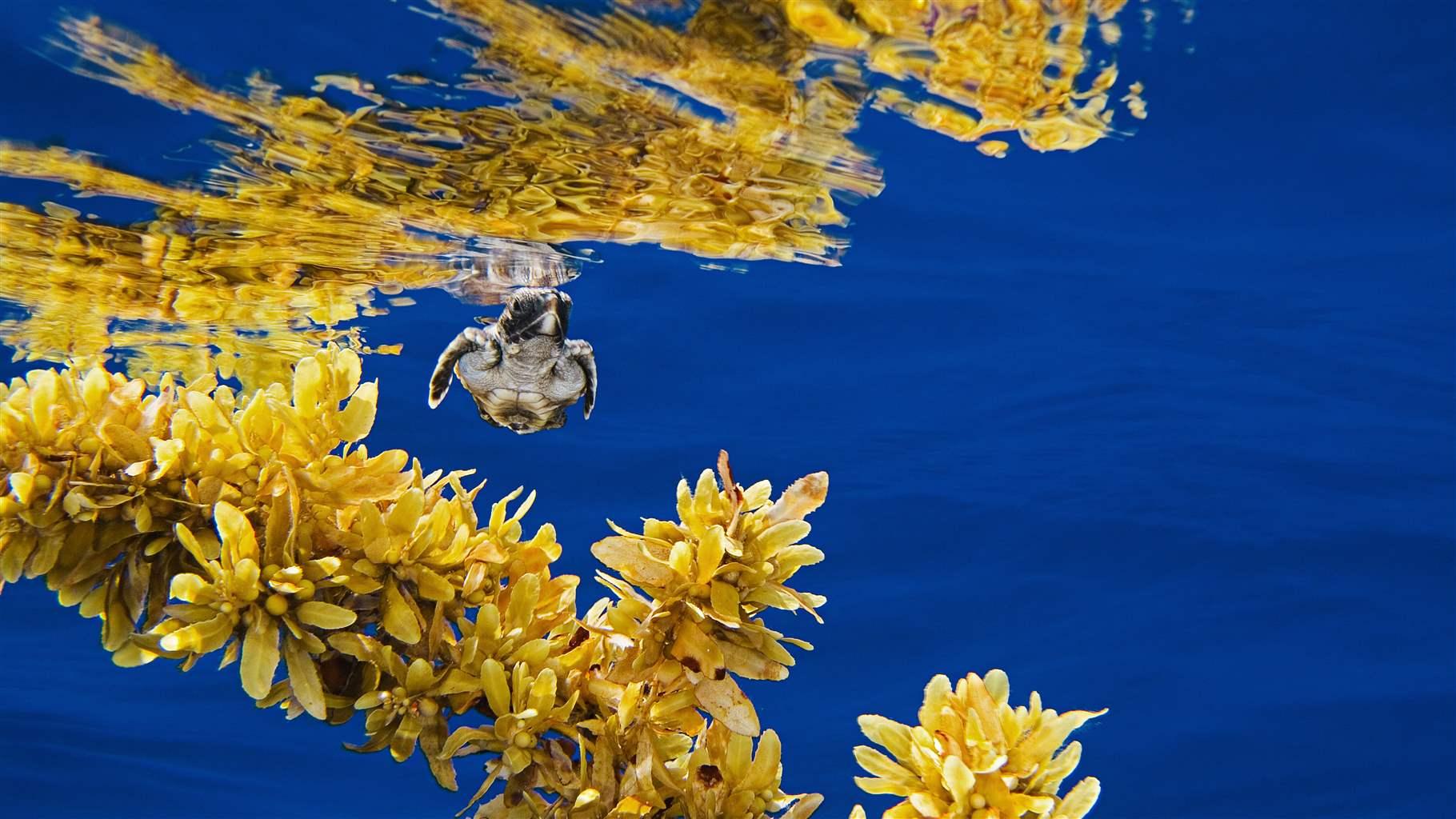A Path to Creating the First Generation of High Seas Protected Areas
Science-based method highlights 10 sites that would help safeguard biodiversity beyond national waters
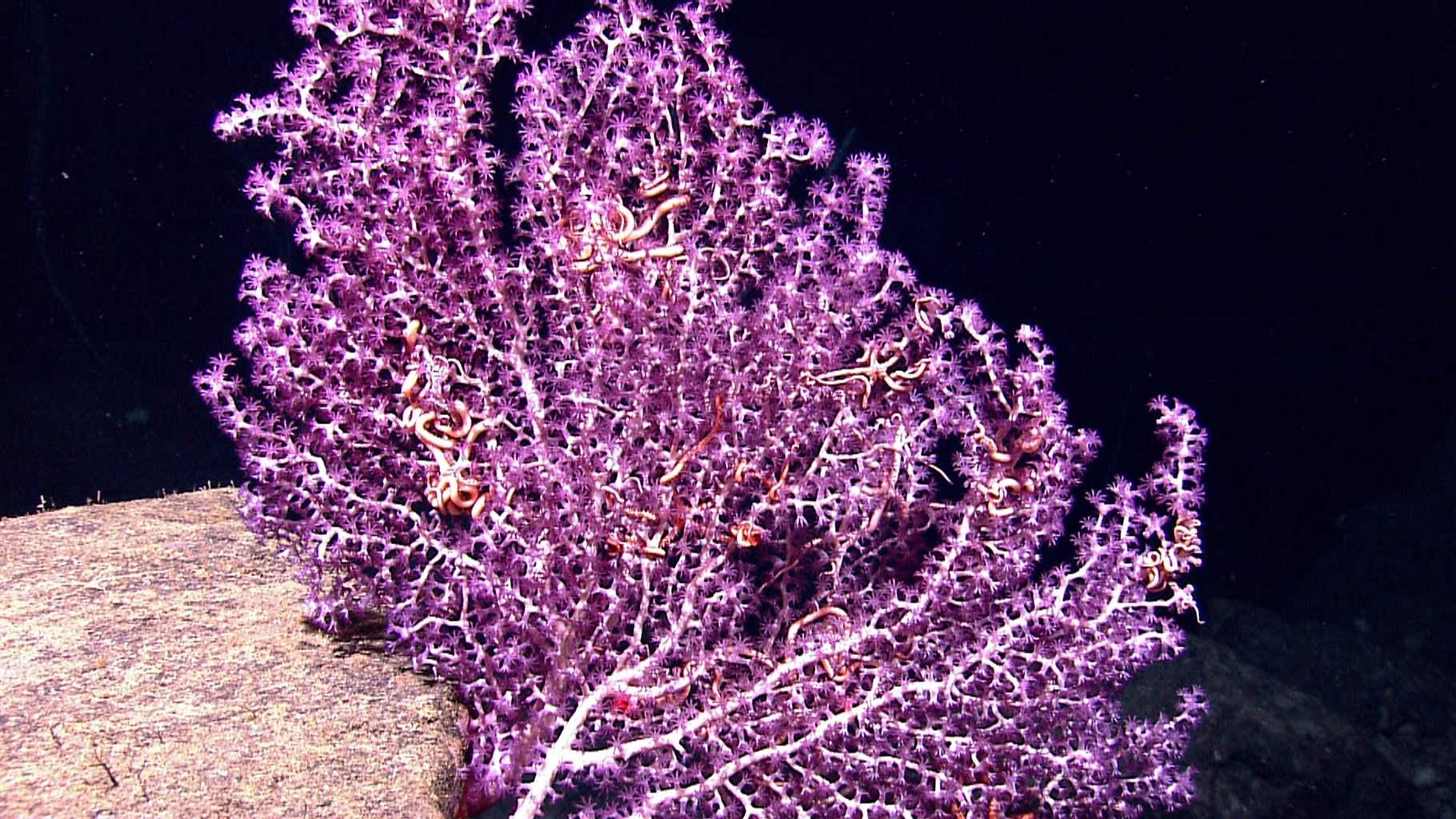
Editor’s note: The content on this page was published before June 2023, when the United Nations adopted a legally binding treaty on the conservation and sustainable use of marine biodiversity in areas beyond national jurisdiction, sometimes referred to as the high seas treaty.
This report was updated on July 14, 2023, to correct the name of the Rapa Nui Multiple Use Marine Coastal Protected Area. In March 2021, the report was updated to add a URL to endnote 31; and in April 2020, the labeling of the Norfolk Deep benthic protected area was corrected.
Overview
Beyond the horizon, more than 200 nautical miles from shore, lies an area of the ocean known as the high seas. These waters, beyond the jurisdiction of any nation, make up roughly two-thirds of the ocean and cover nearly half of the planet’s surface. Much is still to be learned about these areas, but scientists know they teem with life and are among the largest reservoirs of ocean biodiversity. The high seas support abundant fisheries; provide habitat and migratory routes for whales, sharks, sea turtles, and seabirds; and harbor remarkable ecosystems, such as deep-water corals and other majestic marine life.
The high seas are also an increasingly busy space; rapid advances in technology and increasing demand for goods and trade in recent decades mean virtually no part of the ocean—including these waters far from shore— remains untouched by human industrial activity. Currently, a patchwork of different regional and sectoral organizations manages this last global common space with little coordination among organizations, and that is leading to the degradation of the marine environment and its resources. These areas belong to everyone, yet governments currently have no comprehensive legal mechanism in place to protect high seas marine life.
There is an opportunity for this to change. Negotiations are under way at the United Nations to finalize a new high seas treaty focused on the conservation and sustainable use of marine biological diversity beyond national jurisdiction. The treaty could allow nations to establish comprehensive, cross-sector marine protected areas (MPAs) on the high seas. These areas, when well-managed, can be effective tools in building ocean resilience to climate change, avoiding fisheries collapse, and preserving biodiversity. Currently, less than 1 per cent of high seas waters are highly protected, but scientific evidence suggests that protecting at least 30 per cent of the ocean is more likely to achieve long-term ocean health objectives.1 High seas MPAs can play a key role in reaching this target.
Although there is much still to discover, scientists have sufficient data and research to begin mapping and modeling hot spots of biodiversity on the high seas.2 This report identifies some of the special places that could benefit from protections established under a new high seas treaty. The findings build off a project funded by The Pew Charitable Trusts and led by scientists at the University of California, Santa Barbara (UCSB) in conjunction with partners from 13 universities and organizations. Using an algorithm that allows for consideration of multiple factors, researchers developed a data-driven analysis to identify areas in the high seas of outstanding conservation value.
The 10 sites highlighted represent areas with a spectrum and combination of important features, such as species richness, productivity, and habitat diversity. They are located in oceans that span the globe.
This report also includes recommendations to inform the negotiations under way to finalize a new legally binding international agreement. The agreement should ensure the establishment of effective high seas protections, including by setting meaningful conservation objectives and requiring enforceable management plans for these critical waters beyond the jurisdiction of any single nation.
Importance of the high seas
The high seas are vital to life on Earth. With an average depth of more than 4 kilometres (2.5 miles) and a maximum depth of over 10 kilometres (6.2 miles), these waters sustain an array of marine fauna and flora and serve as a throughway for migratory species such as whales, sharks, seabirds, tuna, and sea turtles. Although these areas are remote and have proved difficult to explore, scientists estimate that they represent about 95 per cent of the occupied habitat of Earth and believe there could be millions of undiscovered species beyond national jurisdiction.3
These waters also hold an astonishing variety of tiny microscopic organisms called phytoplankton that produce almost half of the world’s oxygen supply.4 Through photosynthesis, these organisms convert carbon dioxide from other marine life and the atmosphere into the air we breathe. Further, the high seas help to regulate global air temperatures and slow the impact of climate change on land by absorbing and storing excess carbon dioxide from the atmosphere. In 2014, the Global Ocean Commission estimated the economic value of removing this carbon from the atmosphere at US$74 billion to US$222 billion per year.5 At the same time, however, higher levels of carbon dioxide in the atmosphere have contributed to rising ocean temperatures and increased acidity. These changes threaten ecosystems and habitats that marine species depend on and add to problems such as coral bleaching and reduced oxygen concentrations, the process known as deoxygenation.
By contrast, the gross value of the catch in high seas fisheries is estimated at US$7 billion to US$16 billion a year.6 Industrial fishing fleets work in more than half of these ocean areas,7 and over one-third of these fish stocks are overexploited.8 The 2018 State of World Fisheries and Aquaculture report by the United Nations Food and Agriculture Organization (FAO) highlighted the declining status of high seas fish stocks and recognized the need for more effective management measures.9 According to the report, the percentage of stocks fished at biologically unsustainable levels increased from 10 per cent in 1974 to 33.1 per cent in 2015.10
Academic studies suggest that the percentage of overexploited fish stocks may be significantly higher.11 Over the past 50 years, stocks of tuna and other highly migratory tuna-like species such as marlin and mackerel have declined on average by 60 per cent; many are now considered fully or overexploited.12
Deep-sea fishing is also a concern. Species there live in extreme conditions with limited access to light and food. Many, such as deep-sea sharks, are slow to reach sexual maturity and produce young only sporadically, making them especially vulnerable to overfishing.13
Overfishing, however, is not the only threat. Roughly 90 per cent of world trade moves through shipping across the high seas (see Map 1).14 Increased vessel traffic means few wild places completely free of human industrial activity remain. Instead, marine mammals and other species increasingly face threats from ship strikes, noise nuisance, and pollution from ballast water discharges and fuel leaks, all of which contaminate high seas ecosystems.
The health of the ocean is in decline, largely because of increased industrial activity. Even far from shore, the high seas are not immune to the impacts of climate change, plastic pollution, overfishing, shipping, and other threats. The cumulative effects of habitat destruction; pollution; noise from oil, gas, and mineral exploration; shipping; and other human activities now affect 66 per cent of the ocean.15 And as technology develops, emerging activities such as deep-sea mining and geo-engineering pose new risks to high seas marine life and ecosystems.16
MPAs can help protect high seas biodiversity
Although there are more than 20 high seas governance organizations, these bodies vary greatly in their mandates—such as fisheries management, shipping regulation, and seabed mining management—but none has a comprehensive cross-sectoral mandate with regulatory authority and a focus on conservation in areas beyond national jurisdiction. As a consequence, despite widely accepted data showing the economic and environmental value of the high seas, there is little in place to ensure conservation of biodiversity there. Currently only around 1 per cent of these waters are safeguarded in effectively managed and highly protected MPAs.17
Management of these protected areas for conservation can take a number of forms, from no-take reserves where all extractive activities are banned to multiple-use zones, in which certain activities with low ecological impact may be allowed. Scientists have found that MPAs—especially no-take reserves—are effective conservation tools.
Research on similar efforts in domestic waters shows that MPAs yield the greatest conservation benefits when they are large, highly protected, isolated, well-enforced, and long-standing. Benefits increase exponentially when all five features are in place.18 A 2018 analysis found that the average biomass of fish within these marine reserves is 670 per cent greater than in adjacent unprotected areas and 343 per cent greater than in partially protected MPAs.19 Well-designed marine reserves can lead to larger fish populations beyond the boundaries of the protected area, either from “spillover”—the migration of adult fish from the MPA—or the dispersal of larvae spawned within it.20
Effective implementation and management are critical for protecting ocean life.21 MPAs that protect both the water column and the seafloor conserve the marine environment most effectively.22 That’s because species that live in the water column are interlinked with species that live on the seafloor, and both play essential roles in their ecosystems.
Mesopelagic fish, which live in the middle depths, embody this vertical link through the water column. Each day, they travel from the deepest parts of the ocean still penetrated by light to the surface. As they do, they may become food for tuna and other commercially important species. They also bring organic carbon to the deep, thus playing an important, though not yet fully quantified role in mitigating climate change.23 Most seafloor organisms depend on food from the water column sinking to the bottom. Conversely, seamounts at the ocean’s bottom can create upwellings that drive deeper, nutrient-rich water upward, which enhances productivity at the surface.
Highly protected MPAs can also help marine ecosystems, including those on the high seas, better adapt and become more resilient to the impacts of climate change.24 For example, by protecting large adult fish with high egg production, marine reserves can help these populations recover after climate-induced oxygen depletion mass mortalities.25
In the high seas, networks of MPAs that create meaningful links across habitats will benefit highly migratory species such as whales and turtles. A well-connected MPA network can protect important places along their routes, such as feeding or breeding grounds.26 The more time highly migratory species spend in protected areas, the greater the benefits. Therefore, well-designed, well-connected MPA networks are critically important for protecting these species.27
These MPA networks beyond national jurisdiction also could benefit coastal areas—and species that depend on access to shore. Leatherback turtles, for example, spend most of the year on the high seas but travel to coastal areas to lay their eggs. Despite efforts to conserve this endangered species, Pacific leatherback turtle populations fell by more than 95 per cent over 20 to 30 years, a decline scientists attribute largely to deaths as by-catch in the pelagic longline fishery.28 Although protecting nesting areas on coastal beaches is vital to leatherback turtles’ recovery, it is equally critical that these creatures be protected from harmful fishing practices in their high seas habitat.29
The health of the high seas affects that of national waters, especially fisheries. Overfishing key species on the high seas can have devastating consequences for coastal nations, particularly those recognized by the United Nations as least developed, where livelihoods depend upon healthy coastal resources.30
Identifying a first generation of high seas MPAs
The high seas treaty presents an opportunity to protect hot spots of biodiversity and important or unique ecosystems and ecosystem processes. The Pew Charitable Trusts engaged a team of scientists, led by Doug McCauley at the University of California at Santa Barbara (UCSB), to identify areas of exceptional biological and/or ecological value.31
Key factors and methodology
The researchers used a systematic conservation prioritization software called prioritizr R that identifies potential areas that meet conservation objectives while minimizing the opportunity cost, defined as forgone commercial fishing activities in a protected area.32 The algorithm then tries to find a solution that includes areas that meet conservation objectives while avoiding those with a high “cost” associated with them. (For more detail on methodology, see the appendix.)
This analysis did not consider the 200-nautical-mile extent of ocean under national jurisdiction known as the exclusive economic zone (EEZ), consistent with other studies focused on high seas areas.33
The analysis included a total of 54 different data layers of conservation features, grouped into six broad categories, and one cost layer:
Conservation features
Species richness. A measure of the organisms known or hypothesized to exist in specific waters, both now and in hypothesized future conditions, which take into account the anticipated impacts of climate change.
Species extinction risk. An assessment of the vulnerability of these species to extinction, both looking at current conditions and what is likely under a worsening climate-change scenario.
Seamounts. The distribution of large underwater mountains.
Hydrothermal vents. The distribution of high seas hydrothermal vents, unusual seafloor formations in which superheated fluids from deep in the Earth have been or are being released into the water column.
Seafloor habitat diversity. Data that measure benthic biodiversity in the various categories of ocean floor, known by scientists as seascapes that have differing features, such as depth, slope, sediment thickness, dissolved oxygen, and temperature.
Productivity. This measure analyzes chlorophyll concentrations to model primary productivity, or the rate at which plants and other photosynthetic organisms produce organic compounds in an ecosystem.
Cost layer
Fishing effort. This factor measures the amount of fishing in a particular area, which can help target waters that could be protected at minimal cost to the fishing industry.
Although shipping and seabed mining are current and emerging threats to high sea biodiversity, they were not considered in this analysis. Seabed mining claims in areas beyond national jurisdiction were not considered because they are still in the exploratory stage and mining has yet to begin on a commercial scale. Conversely, the shipping industry has a global footprint that affects most of the high seas (see Figure 1). Although this analysis could support decisions to adopt measures that would minimize the negative impact of shipping in important high seas areas, those areas with high levels of shipping traffic were not removed from consideration.
A tool to ensure conservation targets are met
Researchers relied on the prioritizr tool to ensure that conservation targets are met while minimizing the costs of the conservation solution. For each of the 54 data layers described above, the tool was set to select a solution area that protected at least 30 per cent of the conservation features in each individual layer while minimizing overlap with highly fished areas. Map 3 shows the result of that process. In Map 3, those areas that met the conservation target but were removed because they were places with high concentrations of fishing effort—and therefore higher costs—are shown in red.
Results: Important areas to protect in the high seas
The high seas and their biodiversity are critical to the health and ecosystem function of the global ocean and therefore should be protected and used sustainably. This work can serve as a starting point in building towards a goal of safeguarding at least 30 per cent of the ocean in a network of well-connected MPAs.
Many areas known for their extraordinary biodiversity or other conservation features are included in the results. One particularly productive and extraordinary area is the Barents Sea, a relatively shallow area of the Arctic Ocean where the warm Atlantic water carried northward by the Gulf Stream meets the cold Arctic waters.
Animals follow the ice north as it melts, and at least 20 million seabirds reside in this area each summer.34 Meanwhile, at the southern pole, the krill-rich waters of the Antarctic also featured in the conservation solution. Portions of the Southern Ocean near Antarctica already benefit from protections established by the Commission for the Conservation of Antarctic Marine Living Resources (CCAMLR), the international organization that manages these waters.
This report explores 10 other sites that represent the extraordinary value of the high seas areas worthy of protection based on the findings of the UCSB study (see Map 4).
Salas y Gómez and Nazca Ridges
The Salas y Gómez and Nazca Ridges are connected submarine mountain ranges in the southeastern Pacific Ocean with the peak between them located about 2,000 kilometres from mainland Chile. Together they extend nearly 3,000 kilometres (1,864 miles), or roughly the distance from Maine to Florida, and contain at least 110 seamounts at fishable depth in areas beyond national jurisdiction, about 40 per cent of all seamounts in this region of the Pacific.35 Because fishing and other extractive activities in the area have so far been limited, these deep-sea mountains contain some of the world’s highest levels of endemic marine biological diversity and could be important for the survival of still-undiscovered species.36 The seamounts offer refuge to both resident and migratory species, including threatened blue whales and leatherback sea turtles that return to these waters annually to breed and feed.37
The South Pacific Regional Fisheries Management Organisation (SPRFMO) oversees conservation and sustainable use of fishery resources in this region of the Pacific, about a quarter of the Earth’s total high seas area. The target species managed by this RFMO include orange roughy, alfonsino, and jack mackerel, and fishing methods in use include purse seining, pelagic trawling, jigging, bottom trawling, and bottom longlining.38 Trawling in particular has historically had a devastating impact on seafloor habitat.39
In recognition of the area’s biological importance, Chile has designated two areas within its adjacent national waters—the Nazca-Desventuradas Marine Park to the east and the Rapa Nui Multiple Use Marine Coastal Protected Area surrounding Easter Island to the west. As technology for fishing on the high seas improves and coastal stocks are further exploited, destructive bottom fishing in the region could increase.
Costa Rica Dome
A dynamic feature in the eastern tropical Pacific Ocean, the Costa Rica Thermal Dome is formed through a unique interaction of surface winds and surrounding ocean currents that drive deep, cold, nutrient-rich water up towards the warmer surface. Because of the dynamic nature of both surface winds and ocean currents, the dome fluctuates seasonally in its location, though it maintains a relatively constant average position in areas beyond the jurisdiction of Central America’s nations.
The upwelling of nutrient-rich waters drives an explosion of productivity that, in turn, attracts a high diversity of species that feed on the readily available and abundant food. Migratory marine predators such as tuna, dolphins, and cetaceans gather seasonally in these waters to feed. The area is also critical habitat for endangered blue whales and leatherback sea turtles. Under future climate scenarios, the Costa Rica Dome could prove even more critical as a habitat for an increasing number of vulnerable and threatened species in a warmer ocean.40
Efforts are underway to protect the Costa Rica Dome area within national waters and on the high seas in recognition of the uniqueness of its ecological drivers and the life it supports.41 Fishing effort, however, remains a concern, a reality that is complicated because the dome moves with the seasons and is partially within the national waters of Central American countries for about half of the year. With commercial and recreational fishing, as well as wildlife tourism, having a strong presence in the area, life within the dome faces many threats from human activities as it moves between international and domestic waters.
In 2009, the region’s fishing industry brought in approximately US$750 million.42 Notably high marine traffic poses threats of whale strikes, pollution, and other concerns. Given the area’s importance for marine biological diversity, protection of these waters would ensure the long-term survival of the species that live there—and the sustainability of the industries that rely on them.
Lord Howe Rise and South Tasman Sea
Nestled between the EEZs of Australia and New Zealand, the Lord Howe Rise and South Tasman Sea are among the most biodiverse and productive waters beyond national jurisdiction. Together they act as stepping stones along a migratory corridor for marine megafauna such as humpback whales, offering refuge from predators and rich breeding and feeding grounds.
The Lord Howe Rise is a deep-sea plateau directly east of Brisbane. With complex seafloor habitat, the area is known for high species richness. An abundance of threatened species, such as the Gould’s petrel, use these waters as a feeding ground. Scientists expect that more threatened species will be found in this area as waters warm under future climate scenarios.43
The South Tasman Sea, just south of the Lord Howe Rise, includes some of the most productive waters on the high seas. A high number of threatened species, such as black corals, can be found there.44 With important seafloor habitat, including seamounts, species such as humpback and southern right whales use these areas as pit stops between breeding and feeding grounds.
Various international organizations and bodies have recognized the importance of the region,45 and those tasked with managing its resources have identified areas of unique importance. SPRFMO manages active bottom fisheries in the region and has identified multiple vulnerable marine ecosystems (VMEs) for the predicted presence of both octocorals and hard corals at fishable depths within its jurisdiction. But to date, no comprehensive protections have been put into place. Despite the high probability that rare and fragile corals live in these waters, almost none of the area is closed to bottom fishing.
Existing protections are limited to a “move on rule,” which requires fishing operations to move their activities should they encounter deep-water coral or other indicators that they are approaching a VME and share the location of the VME with fisheries managers.46 SPRFMO considers these protocols interim measures until other management arrangements are established.47
Recognizing the significance of the Lord Howe Rise and South Tasman Sea, Australia and New Zealand both have safeguarded adjacent domestic waters, including Lord Howe and Gifford protected areas in Australia and the Norfolk Deep benthic protected area in New Zealand’s waters.48 Increasing protections to ensure ecosystem connectivity in this area would protect this unique habitat and its diverse inhabitants.
Emperor Seamount Chain
Arching northwest of the Hawaiian Islands toward Russia, the Emperor Seamount Chain is a productive and highly biodiverse series of seamounts in the northwest Pacific.49 Formed by volcanic hot spot tracks, the chain’s seamounts create an oceanographic boundary driving an upper water column whirlpool that attracts pelagic species for spawning and adult habitat.50
Recent studies show that these seamounts support high levels of species richness and the presence of threatened species, including deep-sea cold-water coral communities. Such corals are most diverse in bathyal habitats—waters between 800 and 3,500 metres deep, roughly double the maximum depth of the Grand Canyon.51 The Emperor Seamount Chain is the only range of seamounts between the Hawaiian and the Aleutian islands with such species. Because of their deep-sea habitat, these cold-water corals grow slowly and have a lower level of resiliency than their coastal analogs. That makes them especially vulnerable to activities such as bottom fishing.52
The value of the Emperor Seamount Chain ecosystem has been recognized by individual nations and international entities. The southernmost portion of the chain falls within U.S. national waters and is protected as Papahānaumokuākea Marine National Monument, one of the world’s largest MPAs and a UNESCO World Heritage site.53 But the northern Emperor Seamount Chain in areas beyond national jurisdiction has historically faced high fishing pressure along its seamounts and continues to face pressure from bottom fisheries.
Fishing conservation measures along the chain have been limited to interim steps by the North Pacific Fisheries Commission that maintain existing effort levels but limit the geographic scope of bottom fisheries. The Commission has granted exceptions if interests demonstrate they can fish without jeopardizing the environment.54 Protecting the extent of the Emperor Seamount Chain would afford conservation benefits to the entire ecosystem, not only those areas under national jurisdiction.
Mascarene Plateau
Sometimes referred to as the Seychelles-Mauritius Plateau, the Mascarene Plateau in the Indian Ocean arcs from the northern Seychelles Bank down to St. Brandon Island of Mauritius in the south. With areas reaching less than 20 metres deep, the Mascarene Plateau is home to one of the few very shallow water coral reef ecosystems in the high seas, and one of the only regions of seagrasses in such waters.55 The Saya de Malha Bank, in the central portion of the plateau, supports the largest contiguous seagrass beds in the world: 80 to 90 per cent of shallow surfaces are covered by seagrasses.56
The interaction of the plateau with the South Equatorial Current causes enhanced oceanic productivity. This, in turn, supports seabirds such as the wedge-tailed shearwater and marine mammals such as the pygmy blue whale, which uses the area as a breeding and feeding ground.57 Much is still to be discovered on the Mascarene Plateau, but the unexplored areas here are likely to have high species endemism because of the region’s unique oceanographic features and habitats.58
Many international bodies have recognized the significance of the Mascarene Plateau and the surrounding area. Protection of the plateau, therefore, could help protect some of these unique and important ecosystems by expanding on conservation efforts in the region.59
Despite the ecological importance of the Mascarene Plateau, interests are working to exploit the area’s resources for commercial purposes. In 2018, the Joint Commission of the Mauritius-Seychelles Extended Continental Shelf, Mascarene Plateau region opened the joint management area (JMA) for oil and gas exploration.60 The commercial fishing industry remains interested in bottom fishing area seamounts as well.61 To ensure the long-term viability of such a crucial habitat, the Mascarene Plateau would benefit from dedicated international protection and commitment to conservation.
Arabian Sea
Part of the northern Indian Ocean, the Arabian Sea sits just southeast of the Arabian Peninsula. A combination of features in the region, including the sea’s geographically restricted, highly saline and warm surface waters, drives the stratification of oxygen in the water column. These waters beyond the EEZs of India, Pakistan, Oman, and Yemen house what is known as an extreme oxygen minimum zone (OMZ), a distinct and rare feature, between depths of 200 to 1,000 metres, or around as deep as Dubai’s Burj Khalifa building is tall. An extreme OMZ is indicative of a highly populated space in the water column with a high level of oxygen consumption by species present, which leads to nearly no freely available oxygen available to the rest of the ecosystem.
Hospitable to unique fauna such as lanternfishes, flying squid, and pelagic crabs, these Arabian Sea waters have an unusually high presence of mesopelagic animals that travel up and down daily through the water column in search of food and protection. The zone is also home to unique deep-sea creatures that have adapted to such low oxygen conditions as well as large predators such as squids, ribbonfishes, tuna, and billfish that rely on the mesopelagic animals as a key food source.62 Scientists also have identified the Arabian Sea as an important place for both cetacean and shark populations.63 In addition to its high levels of productivity, the sea has remarkable bathymetric features, including hydrothermal vents and several seamounts.64
The uniqueness of this area has been recognized through international designations as well as recent regional conservation efforts.65 Pakistan designated its first MPA in the Arabian Sea on Astola Island in 2017, with a focus on protections for Arabian Sea humpback whales. India, Yemen, Oman, and Somalia have all also established domestic protected areas in their waters, highlighting an opportunity to connect critical habitat in the region.66 Although there is some fishing in the area, marine biodiversity in the Arabian Sea is mostly threatened by vessel pollution and spills, as well as marine mammal strikes in a highly trafficked area.67
Gulf of Guinea
Off the central west African coast, the Gulf of Guinea is a biological hot spot. Powerful upwelling and the convergence of three separate currents drive some of the highest levels of productivity in the high seas. Sediment and nutrients from the Congo River also contribute to the productivity.
Many high seas areas face upper limits on their productivity dictated by the availability of certain nutrients. The influx of nutrient-rich waters from the Congo River helps to ensure that this ecosystem’s productivity is not affected by a scarcity of essential nutrients.
These waters support habitat critical for migration and reproduction of commercially and biologically important species, such as bigeye and yellowfin tuna. Larvae and juveniles, as well as adults, of many species of tuna, swordfish, sharks, and rays all use these waters for their development.68 The area provides habitat for many large marine mammals, including humpback whales, sperm whales, and melon-headed whales.69 Despite its biological importance, the Gulf of Guinea faces serious threats from illegal and unregulated fishing, as well as piracy.70 Experts estimate that more than 50 per cent of fisheries resources from the Nigeria to Senegal coasts are overexploited and that the amount of illegal, unregulated, and unreported fishing is the equivalent of 65 per cent of the legal reported catch for the Gulf of Guinea.71 In 2018, the Gulf of Guinea had the highest rate of piracy incidents of any region, accounting for about 40 per cent of all worldwide that year.72 The compounding threats to ocean resources jeopardize the sustainability of the region’s fisheries as well as the unique and endangered species found there.
Walvis Ridge
The Walvis Ridge is an undersea mountain range that formed as a result of a volcanic hot spot track off the southwestern tip of Africa. Running northeast from Tristan da Cunha, a U.K. overseas territory, towards Namibia, the ridge serves as a barrier—as well as a point of mixing—between North Atlantic deep water and Antarctic bottom water that supports a diverse biological community and high levels of species richness. The area has a high diversity of seafloor features that support a wide array of life.
In addition to seamounts, the area includes a variety of seafloor features such as steep canyons, embayments, abyssal plains, and fossilized cold-water coral reef communities.73 This variation in the slopes, summits, and surface waters supports a varied ecological community, one likely to be of particular importance for vulnerable species associated with the ridge’s seamounts.74
The fishing footprint is relatively small in the region, and some of the seamounts are off-limits to bottom fishing—in recognition of their ecological value—through the designation of VME fishery closures. The significant value of the Walvis Ridge, supported by scientific recommendations for a precautionary approach to its use, warrants international protections to safeguard a unique and important habitat from irreversible damage.
Sargasso Sea and Corner Rise Seamounts
The Sargasso Sea and Corner Rise Seamounts are located in the central to western Atlantic. An important habitat largely defined by its characteristic sargassum seaweeds and the diverse ecosystem it supports, the Sargasso Sea has ecological importance rivaled by few places in the world. Geographically defined by its surrounding currents, the sea provides habitat for many critically important and endemic species, such as European and American eels.75
It offers broader benefits by supporting global oceanographic processes such as carbon sequestration and oxygen production.76 At some point in their lifetimes, 100 species of invertebrates, more than 280 species of fish, and some 23 types of birds use the sea’s sargassum for protection, food, spawning, or nursery habitat. These include 10 species found nowhere else on the planet, such as the sargassum angler fish, which has camouflage uniquely adapted to these floating forests.
Other migratory species, such as tuna and marlin, feed off the diverse communities of smaller organisms living in the sargassum, making this area critical to the productivity of commercial fisheries throughout the Atlantic. The value of these fisheries has been estimated at about US$100 million per year.77 Along the northeastern portion of the Sargasso Sea, the Corner Rise Seamounts includes a chain of underwater mountains that rise to within 200 metres of the surface. These waters harbor complex faunal assemblages, including corals and sponges, as well as many threatened or vulnerable species. Hydrothermal vents and the productive waters that surround the steep slopes of the Corner Rise Seamounts support more than 175 species of fish.78
Fisheries closures, in the form of VMEs, dot many of the area’s seamounts, protecting them from bottom fishing through 2020.79 But with a large historic fishing footprint among the seamounts and only temporary protections, the region could face fishery exploitation.80 Other potential risks include mining and vessel traffic, which create a need to manage invasive species from ballast water.
The area has been recognized for its uniqueness and its contributions to global ocean processes. The Sargasso Sea Commission has been working to promote better understanding of this ecosystem and coordinate regional and sectoral conservation efforts. The Commission’s work has brought together a number of governments and partners to secure adequate protection for this exceptional ecosystem. However, without an overarching governance mechanism for comprehensive protection in areas beyond national jurisdiction, the efforts to protect the Sargasso Sea remain cumbersome and fragmented across many different international bodies.81
A new treaty can spur creation of high seas MPAs
Today, a patchwork of international bodies and treaties manages resources and human activity in areas beyond any state’s national jurisdiction. These organizations, which oversee activities such as fishing, whaling, shipping, and seabed mining, vary greatly in their mandates, which determine their geographic scope, objectives, the legally binding nature of their decisions, and what activities they regulate. Their jurisdictions often overlap, and, too often, this piecemeal approach leads to degradation of the environment and its resources.
It also makes deploying management and conservation tools such as MPAs challenging both legally and logistically.82 Ongoing negotiations at the United Nations on a high seas treaty offer an opportunity to address current gaps in ocean governance to allow for comprehensive protection of marine biodiversity in the high seas. To ensure that current and future generations continue to reap benefits from the high seas, the agreement must include a global mechanism to establish a network of well-connected and representative high seas MPAs.
A new international agreement should provide the following:
- A global mechanism to identify and establish high seas MPAs. Setting up a central decision-making body through which States can propose and agree on the establishment of MPAs in these waters would provide a path towards creating such zones.
- A framework for adopting meaningful conservation objectives and enforceable management plans. Maintaining the current approach would be ineffective because most of the sectoral bodies lack the needed expertise or a mandate to protect biodiversity. High seas MPAs created with concrete objectives, management plans, and enforcement protocols are more likely to protect biodiversity than areas established without such specific parameters.
- A means of consulting and collaborating with sectoral and regional organizations. Under the new instrument, parties should be able to formally consult with existing sectoral bodies and similar organizations. These consultations would help to avoid conflict between management measures adopted under the new treaty and pre-existing obligations to those organizations. States can encourage such organizations to adopt complementary measures recognizing high seas MPAs but should not allow these efforts to delay establishment or implementation of such MPAs.
- The tools to ensure effective implementation. The new agreement should help with the effective implementation of MPAs by obliging parties to ensure that vessels and activities under their jurisdiction abide by relevant management measures and report instances of non-compliance. A body established by the treaty should monitor implementation and compliance. To ensure better enforcement, monitoring, and data-sharing, the agreement should facilitate capacity building and the transfer of marine technology.
The task of protecting the high seas starts with identifying important places in the ocean that need protection. Notable intergovernmental efforts include the regionally based, expert-driven process to identify ecologically and biologically significant areas (EBSAs) under the Convention on Biological Diversity (CBD)83 as well as UNESCO World Heritage sites. UNESCO encourages the protection of areas of outstanding cultural or natural value.84 As of 2016, over 65 EBSAs either partially or entirely in the high seas have been identified.85
Other studies also have endeavored to identify special places in the ocean.86 Although the approach used in this analysis differs from those efforts, it identified many of the same areas. This underscores that scientists and decision makers have the information, data, and tools to readily identify areas of biological importance in areas beyond national jurisdiction. So, although there is still much to understand and discover about the half of the planet that makes up the high seas, limits on scientific information cannot be an excuse for inaction.
Some of these areas have benefited from limited single-sector protections such as stricter fishing regulations, while others have gained from special cooperative efforts by adjacent coastal nations to conserve or sustainably use their waters. However, the state of the ocean continues to decline. The global community must improve upon the status quo of ocean governance by finalizing a robust and ambitious high seas treaty.
Conclusion
The high seas teem with marine life. They act both as habitats and thoroughfares for migratory species and benefit from unique features and ecological processes that provide the cornerstones of communities of untold numbers of rare and endemic species. This report provides a brief tour of particularly valuable high seas areas that would benefit from comprehensive protections such as those envisioned in the negotiations for a new high seas treaty. The analysis led by the UCSB researchers demonstrates that although there is still much to be discovered in areas beyond national jurisdiction, there is enough scientific data available to be able to start identifying sites that would make excellent high seas MPA candidates.
Because the health and functioning of the ocean is declining at an alarming rate, the world’s governments must take bold and urgent action to ensure that the ocean continues to provide the benefits and resources upon which so many depend. Those include resilience to climate change, maintenance of ecosystem functions, and conservation of marine life and healthy fish stocks. High seas MPAs can help meet these objectives, but currently there is no legal mechanism in place for establishing comprehensive, multisector protected areas.
A new high seas treaty offers an opportunity to create such a tool, and policymakers should come to terms on a robust global agreement to ensure the conservation and sustainable use of marine biodiversity for current and future generations.
Appendix: Methodological details
Key factors and methodology
The analysis by researchers at UCSB relied on prioritizr R, a systematic conservation prioritization software that identifies protected area solutions that meet conservation objectives while minimizing the “cost” associated with conserving these regions. The algorithm is set up to select specific areas that meet a variety of conservation objectives while avoiding those areas with a high “cost” associated with them (in this exercise, areas with high concentrations of fishing were considered “high cost”). The system has similar functionality to the Marxan conservation planning program, although prioritizr uses exact algorithms to find optimal conservation solutions.
For this analysis, areas of the water column within any nation’s jurisdiction, typically known as the exclusive economic zones (EEZ), were removed. EEZ boundary data were obtained from MarineRegions.org. This approach is consistent with other studies focused on high seas areas.87 The resulting areas were then divided into 50.1 kilometre x 50.1 kilometre square planning units. Six conservation feature layers were used in the algorithm: species richness (both now and in a climate-future scenario), species extinction risk (both now and in a climatefuture scenario), seamounts, hydrothermal vents, seafloor habitat diversity, and productivity; the analysis also included one cost layer (fishing effort). The data layers were overlaid with the planning units, and the prioritizr tool algorithms determined whether that planning area should be included in the conservation solution.
The prioritizr tool ensures that all conservation objectives are met in the targeted areas while minimizing the costs of the conservation solution. The tool was set to select a solution area that protected at least 30 per cent of the conservation features in the 54 individual data layers while minimizing overlap with highly fished areas.
Species richness
To capture the known organisms that exist, or are thought to exist, in specific areas, data from AquaMaps were used to determine species richness.88 AquaMaps predicts the relative probability of a species occurring in a given area based on environmental data such as depth, temperature, salinity, and the habitat preferences of that species. In this analysis, 11,900 species from the AquaMaps data were considered and grouped into 23 major taxonomic groups.
To incorporate the projected impact of climate change, researchers used a similar method, examining data projections from the AquaMaps 2100 model. That model estimates where species are likely to occur in 2100, based on predictions of global climate change conditions.
In the end, 46 different species richness layers were analyzed by the prioritizr function: 23 taxonomic groups in current ocean conditions, and the same groups under the climate-changed scenario.
Species extinction risk
The analysis also considered the vulnerability of those species to extinction. To capture this, the team used IUCN extinction risk data, excluding data-deficient species. The IUCN Red List categories were given a value (Critically Endangered=4, Endangered=3, Vulnerable=2, Near Threatened=1 or Least Concern=0); the Red List score for each of the species present in a given planning unit were assessed and then were added together. Researchers repeated this process for the AquaMaps 2100 distribution data, though this layer does not consider other drivers of extinction risk, such as ocean acidification. This resulted in two “species extinction risk” layers—one representing current species extinction risk, and another representing future risk under a climate-changed scenario.
Seamounts
Seamounts are large underwater mountains, and a great breadth of biodiversity—deep-sea corals, mollusks, crustaceans, and large schools of fish—live among them. The depth of the seamount influences the type of biodiversity it supports. The extent that light penetrates shallower seamounts, for example, dramatically affects the types of life that can survive and thrive there.89 The analysis used global seamount distribution data measured by satellites and described by scientists Seung-Sep Kim and Paul Wessel in 2011.90
To capture the range of expected biodiversity associated with seamounts in areas beyond national jurisdiction, the team incorporated three seamount layers into the prioritizr tool, one for each of the representative seamount depth categories identified by Clark et al. (2011): 0-200 metres (the sunlight zone: seamount summits in shallower depths, still within the areas of the ocean penetrated by light), 201-800 metres (the twilight zone: seamount summits in the zone in which mesopelagic fish, and other animals that vertically migrate within the water column, can be found), and >800 metres (the midnight zone: the lower bathyal biogeographic zone).91
The types of organisms found at each depth class can vary considerably. Deeper in the water column, light penetration and temperature decrease while pressure increases, resulting in uniquely evolved species at different seamount depths.
Hydrothermal vents
Hydrothermal vents are unusual seafloor formations in which superheated fluids from deep in the Earth have been or are being released into the water column. Despite the intense heat and lack of sunlight, marine organisms, including fish, shrimp, and mussels, can thrive in these waters. Scientists are discovering new species near hydrothermal vents at high rates, in large part because those found near the vents are often unique to that particular vent system.92 To capture hydrothermal vents, researchers used vent distribution data from the InterRidge Vents Database managed by InterRidge, a non-profit organization that promotes ocean floor research.93
Seafloor habitat diversity
The great diversity of habitat on the ocean floor supports correspondingly diverse ecosystems. To take this benthic biodiversity into account, the analysis used one data layer of seafloor characteristics that was developed by scientists Peter T. Harris and Tanya Whiteway. Harris and Whiteway (2009) incorporated global data on six biological and physical seafloor characteristics (depth, seabed slope, sediment thickness, primary production, bottom water dissolved oxygen, and bottom temperature) to identify areas with diverse habitat characteristics, and thus potentially diverse life.94
Productivity
Tiny microscopic organisms known as phytoplankton are the basis of the food chain in the ocean and are responsible for most of the oceanic primary productivity. As such, these organisms play an important role in shaping the behavior of high seas species. This analysis uses a productivity data layer from Oregon State University that relies on a “vertically generalized production model” (VGPM), a common method for estimating primary productivity in the ocean. The VGPM models primary productivity in specific waters by examining chlorophyll concentrations detectable from satellites, depth of the seafloor, and photosynthetically available light.95
Fishing effort
Fish represent an integral component of ocean biodiversity, but fishing has become a major industry in the high seas. This data layer was used as a “cost,” so the algorithm tried to find a solution that avoided areas in which there was a high level of fishing to minimize the loss of key fishing areas. Researchers used a data set describing the global distribution of high seas fishing effort (in kilowatt hours) published by Sala et al. in the journal Science Advances in 2018.
Researchers created this map of fishing effort using data from automatic identification systems (AIS) and vessel monitoring systems (VMS), which are GPS-like tracking systems on most large fishing vessels in the high seas. To minimize conflict with areas with the highest concentration of fishing effort, the conservation planning software sought to avoid including areas that contained the top quartile of fishing effort in the candidate marine protected areas solution.
Other factors
Although shipping and seabed mining are current and emerging threats to high seas biodiversity, they were not considered in this analysis. Seabed mining claims in areas beyond national jurisdiction are still in the exploratory stage, and mining has yet to begin on a commercial scale. Conversely, the shipping industry has a global footprint that affects most of the high seas. Although this analysis could support decisions to adopt measures that would minimize the negative impact of shipping in important high seas areas, high levels of shipping traffic are so pervasive that those areas were not removed from consideration.
Endnotes
- B.C. O’Leary et al., “Effective Coverage Targets for Ocean Protection,” Conservation Letters 9, no. 6 (2016): 398-404, http://dx.doi.org/10.1111/conl.12247; N.J. Gownaris et al., “Gaps in Protection of Important Ocean Areas: A Spatial Meta-Analysis of Ten Global Mapping Initiatives,” Frontiers in Marine Science 6, no. 650 (2019), http://search.ebscohost.com/login.aspx?direct=true&db=edsgao&AN=edsgcl.603805611&site=eds-live&authtype=sso&custid=s3229936.
- European Marine Board, “Delving Deeper: Critical Challenges for 21st Century Deep-Sea Research” (2015), http://www.marineboard.eu/publication/delving-deeper-critical-challenges-21st-century-deep-sea-research.
- United Nations, “The Conservation and Sustainable Use of Marine Biological Diversity of Areas Beyond National Jurisdiction: A Technical Abstract of the First Global Integrated Marine Assessment” (2017), http://www.un.org/depts/los/global_reporting/8th_adhoc_2017/
Technical_Abstract_on_the_Conservation_and_Sustainable_Use_of_marine_Biological_Diversity_of_Areas_Beyond_National_
Jurisdiction.pdf; C. Mora et al., “How Many Species Are There on Earth and in the Ocean?,” PLOS Biology 9, no. 8 (2013): e1001127, https://doi.org/10.1371/journal.pbio.1001127. - Global Ocean Commission, “From Decline to Recovery: A Rescue Package for the Global Ocean” (2014), http://www.some.ox.ac.uk/wp-content/uploads/2016/03/GOC_report_2015.July_2.pdf.
- Ibid.
- Global Ocean Commission, “From Decline to Recovery”; E. Sala et al., “The Economics of Fishing the High Seas,” Science Advances 4, no. 6 (2018): eaat2504, 10.1126/sciadv.aat2504.
- S. Diaz et al., “Summary for Policymakers of the Global Assessment Report on Biodiversity and Ecosystem Services of the Intergovernmental Science-Policy Platform on Biodiversity and Ecosystem Services” (2019), https://ipbes.net/sites/default/files/inline/files/ipbes_global_assessment_report_summary_for_policymakers.pdf.
- Food and Agriculture Organization of the United Nations, “The State of World Fisheries and Aquaculture 2018: Meeting the Sustainable Development Goals” (2018), http://www.fao.org/state-of-fisheries-aquaculture.
- Ibid.
- Ibid.
- C. Costello et al., “Global Fishery Prospects Under Contrasting Management Regimes,” Proceedings of the National Academy of Sciences of the United States of America 113, no. 18 (2016): 5125-29, https://doi.org/10.1073/pnas.1520420113; B. Worm, “Averting a Global Fisheries Disaster,” Proceedings of the National Academy of Sciences of the United States of America 113, no. 18 (2016): 4895, https://doi.org/10.1073/pnas.1604008113.
- M. José Juan-Jordá et al., “Global Population Trajectories of Tunas and Their Relatives,” Proceedings of the National Academy of Sciences of the United States of America 108, no. 51 (2011): 20650-55, https://doi.org/10.1073/pnas.1107743108; G. Ortuño Crespo and D.C. Dunn, “A Review of the Impacts of Fisheries on Open-Ocean Ecosystems,” ICES Journal of Marine Science 74, no. 9 (2017): 2283-97, https://doi.org/10.1093/icesjms/fsx084.
- E.A. Norse et al., “Sustainability of Deep-Sea Fisheries,” Marine Policy 36, no. 2 (2012): 307-20, https://doi.org/10.1016/j.marpol.2011.06.008.
- U.N.-Business Action Hub, “IMO Profile,” accessed Sept. 9, 2019, https://business.un.org/en/entities/13.
- Diaz et al., “Summary for Policymakers.”
- M. Gagain, “Climate Change, Sea Level Rise, and Artificial Islands: Saving the Maldives’ Statehood and Maritime Claims Through the ‘Constitution of the Oceans,’” Colorado Journal of International Environmental Law and Policy, no. 1 (2012): 77-120, https://heinonline.org/HOL/Page?handle=hein.journals/colenvlp23&div=6&id=&page=.
- Marine Conservation Institute, “Atlas of Marine Protection: Global MPAs,” accessed May 14, 2019, http://www.mpatlas.org/map/mpas.
- G.J. Edgar et al., “Global Conservation Outcomes Depend on Marine Protected Areas With Five Key Features,” Nature 506 (2014): 216, http://dx.doi.org/10.1038/nature13022.
- E. Sala and S. Giakoumi, “No-Take Marine Reserves Are the Most Effective Protected Areas in the Ocean,” ICES Journal of Marine Science 75, no. 3 (2017): 1166-68, https://doi.org/10.1093/icesjms/fsx059.
- R.A. Abesamis and G.R. Russ, “Density-Dependent Spillover From a Marine Reserve: Long-Term Evidence,” Ecological Applications 15, no. 5 (2005): 1798-812, https://esajournals.onlinelibrary.wiley.com/doi/10.1890/05-0174.
- D.A. Gill et al., “Capacity Shortfalls Hinder the Performance of Marine Protected Areas Globally,” Nature 543 (2017): 665-69, https://www.nature.com/articles/nature21708.
- Ibid.
- Ibid.
- Sala and Giakoumi, “No-Take Marine.”
- Ibid.; F. Micheli et al., “Evidence That Marine Reserves Enhance Resilience to Climatic Impacts,” PLOS One 7, no. 7 (2012): 1-8, https://doi.org/10.1371/journal.pone.0040832; C.M. Roberts et al., “Marine Reserves Can Mitigate and Promote Adaptation to Climate Change,” Proceedings of the National Academy of Sciences (2017): 6167-6175, https://www.pnas.org/content/pnas/early/2017/05/31/1701262114.full.pdf.
- K.M. Gjerde and A. Rulska-Domino, “Marine Protected Areas Beyond National Jurisdiction: Some Practical Perspectives for Moving Ahead,” International Journal of Marine and Coastal Law 27, no. 2 (2012): 351-73, https://doi.org/10.1163/157180812X633636.
- Ibid.
- Ortuño Crespo and Dunn, “A Review of the Impacts of Fisheries”; J.R. Spotila et al., “Pacific Leatherback Turtles Face Extinction,” Nature 405, no. 6786 (2000): 529-30, https://doi.org/10.1038/35014729.
- Spotila et al., “Pacific Leatherback Turtles.”
- E. Popova et al., “Ecological Connectivity Between the Areas Beyond National Jurisdiction and Coastal Waters: Safeguarding Interests of Coastal Communities in Developing Countries,” Marine Policy 104 (2019): 90-102, https://doi.org/10.1016/j.marpol.2019.02.050.
- The results of this project are going to be published in Marine Policy, a peer-reviewed journal focusing on ocean policy studies: M. Visalli et al., “Data-Driven Approach for Highlighting Priority Areas for Protection in Marine Areas Beyond National Jurisdiction,” Marine Policy 122 (2020): 103927, https://doi.org/10.1016/j.marpol.2020.103927.
- J.O. Hanson et al., Prioritizr: Systematic Conservation Prioritization in R—R Package Version 4.1.4, 2019, accessed Nov. 27, 2019, https://github.com/prioritizr/prioritizr.
- N.C. Ban et al., “Systematic Conservation Planning: A Better Recipe for Managing the High Seas for Biodiversity Conservation and Sustainable Use,” Conservation Letters 7, no. 1 (2014): 41-54, https://doi.org/10.1111/conl.12010; C. White and C. Costello, “Close the High Seas to Fishing?,” PLOS Biology 12, no. 3 (2014): 1-5, http://search.ebscohost.com/login.aspx?direct=true&db=a9h&AN=95435102&site=eds-live&authtype=sso&custid=s3229936.
- Norwegian Polar Institute, “The Barents Sea,” accessed Jan. 28, 2020, http://www.arcticsystem.no/en/arctic-inc/barentssea.html; H. Loeng, “Features of the Physical Oceanographic Conditions of the Barents Sea,” Polar Research 10, no. 1 (1991): 5-18, https://onlinelibrary.wiley.com/doi/abs/10.1111/j.1751-8369.1991.tb00630.x.
- Marine Conservation Institute, “Salas y Gomez and Nazca Ridges,” accessed Oct. 15, 2019, http://www.mpatlas.org/campaign/sala-y-gomez-and-nazca-ridges/.
- National Science Foundation, “New Map Uncovers Thousands of Unseen Seamounts on Ocean Floor,” accessed Jan. 28, 2020, https://www.nsf.gov/news/news_summ.jsp?cntn_id=132771.
- Food and Agriculture Organization of the United Nations, “Vulnerable Marine Ecosystems Database,” accessed Oct. 9, 2019, http://www.fao.org/in-action/vulnerable-marine-ecosystems/vme-database/en/vme.html; Convention on Biological Diversity, “Ecologically or Biologically Significant Areas (EBSAs) Salas Y Gomez and Nazca Ridges” (2017), https://chm.cbd.int/database/record?documentID=204100.
- South Pacific Regional Fisheries Management Organization, “SPRFMO,” accessed Jan. 12, 2020, https://www.sprfmo.int/.
- L. Watling, “The Global Destruction of Bottom Habitats by Mobile Fishing Gear,” in Marine Conservation Biology: The Science of Maintaining the Sea’s Biodiversity, eds. E.A. Norse and L.B. Crowder (Island Press, 2005).
- M. Visalli et al., “Data-Driven Approach.”
- Global Ocean Biodiversity Initiative, “The Costa Rica Thermal Dome,” accessed Jan. 12, 2020, http://gobi.org/projects/iki_wp3_crtd/; Convention on Biological Diversity, “Ecologically or Biologically Significant Areas (EBSAs) Upwelling System of Papagayo and Adjacent Areas” (2016), https://chm.cbd.int/database/record?documentID=204044.
- Center for Ocean Solutions, “Pacific Ocean Synthesis: Scientific Literature Review of Coastal and Ocean Threats, Impacts, and Solutions” (2009), http://www.indiaenvironmentportal.org.in/content/276578/pacific-ocean-synthesis-scientific-literature-review-of-coastal-and-ocean-threats-impacts-and-solutions/.
- M. Visalli et al., “Data-Driven Approach.”
- Ibid.
- Convention on Biological Diversity, “Ecologically or Biologically Significant Areas (EBSAs) South Tasman Sea” (2015), https://chm.cbd.int/database/record?documentID=200048; Mission Blue, “Lord Howe Rise,” accessed Jan. 12, 2020, https://hopespots.mission-blue.org/info?hs_id=39.
- Marine Conservation Institute, “Global MPAs”; S. Hansen, P. Ward, and A. Penney, “Identification of Vulnerable Benthic Taxa in the Western SPRFMO Convention Area and Review of Move-On Rules for Different Gear Types” (2013), https://www.sprfmo.int/assets/Meetings/Meetings-2013-plus/SC-Meetings/1st-SC-Meeting-2013/SC-01-09-Identification-of-VMEs-in-the-western-SPRFMO-Area-and-move-on-rules.pdf.
- Hansen et al (2013). “Identification of Vulnerable Benthic Taxa.”
- Marine Conservation Institute, “Global MPAs.”
- M. Visalli et al., “Data-Driven Approach.”
- Convention on Biological Diversity, “Ecologically or Biologically Significant Areas (EBSAs) Emperor Seamount Chain and Northern Hawaiian Ridge” (2016), https://chm.cbd.int/database/record?documentID=204131.
- National Park Service, “Park Statistics,” accessed Jan. 12, 2020, https://www.nps.gov/grca/learn/management/statistics.htm; Schmidt Ocean Institute, “Deep Coral Diversity at Emperor Seamount Chain 2019,” accessed Jan. 12, 2020, https://schmidtocean.org/cruise/deep-coral-diversity-emperor-seamounts2019/.
- Schmidt Ocean Institute, “Deep Coral Diversity.”
- Papahanaumokuakea Marine National Monument, “About Papahanaumokuakea,” accessed Oct. 14, 2019, https://www.papahanaumokuakea.gov/new-about/.
- Marine Conservation Institute, ”Global MPAs”; North Pacific Fisheries Commission, Conservation and Management Measure for Bottom Fisheries and Protection of Vulnerable Marine Ecosystems in the Northwestern Pacific Ocean (2018), https://www.npfc.int/cmm-2018-05-bottom-fisheries-and-protection-vmes-nw-pacific-ocean.
- W. Hilbertz et al., “Saya de Malha Expedition” (2002), http://www.wolfhilbertz.com/downloads/2002/saya_2002_rev1.pdf.
- United Nations Educational, Scientific and Cultural Organization, “Saya De Malha Bank, Mascarene Plateau,” accessed Jan. 30, 2020, http://www.vliz.be/projects/marineworldheritage/sites/2_Masc%20Plateau_S%20Malha.php?item=The%20Indian%20Ocean.
- Ibid.
- Convention on Biological Diversity, “Ecologically or Biologically Significant Areas (EBSAs) Saya De Malha Bank” (2015), https://chm.cbd.int/database/record?documentID=204017.
- Marine Conservation Institute, “Global MPAs.”
- Offshore Magazine, “Mauritius, Seychelles to License Joint Offshore Area,” news release, Nov. 8, 2018, https://www.offshore-mag.com/regional-reports/article/16802894/mauritius-seychelles-to-license-joint-offshore-area.
- Marine Conservation Institute, “Global MPAs.”
- Convention on Biological Diversity, “Ecologically or Biologically Significant Areas (EBSAs) Arabian Sea Oxygen Minimum Zone” (2017), https://chm.cbd.int/database/record?documentID=237787.
- IUCN-Cetacean Specialist Group, “Arabian Sea Humpback Whales,” accessed Jan. 12, 2020, https://iucn-csg.org/csg-special-projects/arabian-sea-humpback-whales/.
- Convention on Biological Diversity, “Ecologically or Biologically Significant Areas (EBSAs) Arabian Sea Oxygen Minimum Zone.”
- Ibid.
- Marine Conservation Institute, “Global MPAs.”
- M.A. Vazquez, K.W. Allen, and Y.M. Kattan, “Long-Term Effects of the 1991 Gulf War on the Hydrocarbon Levels in Clams at Selected Areas of the Saudi Arabian Gulf Coastline,” Marine Pollution Bulletin 40, no. 5 (2000), 440-448.
- Convention on Biological Diversity, “Ecologically or Biologically Significant Areas (EBSAs) Zone de Production Équatoriale de Thons” (2015), https://chm.cbd.int/database/record?documentID=204067.
- C.R. Weir, “A Review of Cetacean Occurrence in West African Waters From the Gulf of Guinea to Angola,” Mammal Review 40, no. 1 (2010): 2-39, http://search.ebscohost.com/login.aspx?direct=true&db=eih&AN=47481750&site=eds-live&authtype=sso&custid=s3229936.
- I. Okafor-Yarwood, “Illegal, Unreported and Unregulated Fishing, and the Complexities of the Sustainable Development Goals (SDGs) for Countries in the Gulf of Guinea,” Marine Policy 99 (2019): 414-422, https://www.sciencedirect.com/science/article/pii/S0308597X17303445?via%3Dihub; The Economist, “The Gulf of Guinea Is Now the World’s Worst Piracy Hotspot,” June 29, 2019, https://www.economist.com/international/2019/06/29/the-gulf-of-guinea-is-now-the-worlds-worst-piracy-hotspot.
- I. Okafor-Yarwood “Illegal, Unreported and Unregulated Fishing.”
- ICC International Maritime Bureau, “Piracy and Armed Robbery Against Ships” (2019).
- Nelson Mandela University, “Walvis Ridge Namibia,” accessed Jan. 12, 2020, https://cmr.mandela.ac.za/EBSA-Portal/Namibia/Walvis-Ridge-Namibia.
- Convention on Biological Diversity, “Ecologically or Biologically Significant Areas (EBSAs) Walvis Ridge,” accessed Jan. 12, 2020, https://chm.cbd.int/database/record?documentID=204084.
- Ibid.
- Convention on Biological Diversity, “Ecologically or Biologically Significant Areas (EBSAs) Sargasso Sea,” accessed Jan. 12, 2020, https://chm.cbd.int/database/record?documentID=200098.
- L. Pendleton et al., “Assessing the Economic Contribution of Marine and Coastal Ecosystem Services in the Sargasso Sea” (2014), https://nicholasinstitute.duke.edu/sites/default/files/publications/ni_r_14-05_full_pdf.pdf.
- Convention on Biological Diversity, “Ecologically or Biologically Significant Areas (EBSAs) New England and Corner Rise Seamounts,” accessed Jan. 12, 2020, https://chm.cbd.int/database/record?documentID=204106; T.M. Shank, “Spotlight 4: New England and Corner Rise Seamounts,” Oceanography 23, no. 1 (2010): 104-5, https://doi.org/10.5670/oceanog.2010.76.
- Food and Agriculture Organization of the United Nations, Vulnerable Marine Ecosystems Database.
- Ibid.
- Sargasso Sea Commission, “About Our Work,” accessed Jan. 12, 2020, http://www.sargassoseacommission.org/about-our-work.
- Ban et al., “Systematic Conservation Planning.”
- Convention on Biological Diversity, “Background on the EBSA Process,” accessed Oct. 17, 2019, https://www.cbd.int/ebsa/about.
- UNESCO, “About World Heritage,” accessed Oct. 17, 2019, https://whc.unesco.org/en/about/.
- N.J. Bax et al., “Results of Efforts by the Convention on Biological Diversity to Describe Ecologically or Biologically Significant Marine Areas,” Conservation Biology 30, no. 3 (2016): 571–81, http://search.ebscohost.com/login.aspx?direct=true&db=edsbas&AN=edsbas.9C292A8E&site=eds-live&authtype=sso&custid=s3229936.
- Mission Blue, “Hope Spots: An Actionable Plan to Save the Ocean,” accessed Oct. 17, 2019, https://mission-blue.org/2016/06/hope-spots-an-actionable-plan-to-save-the-ocean/#targetText=Hope%20Spots%20are%20areas%20in,Spot%20in%20the%20Indo%2DPacific; Greenpeace, “30x30: A Blueprint for Ocean Protection,” accessed Jan. 12, 2020, https://greenpeaceoceanblueprint.org/; Gownaris et al., “Gaps in Protection.”
- Ban et al., “Systematic Conservation Planning”; White and Costello, “Close the High Seas to Fishing?”
- K. Kaschner et al., AquaMaps: Predicted Range Maps for Aquatic Species, accessed Nov. 27, 2019, www.aquamaps.org.
- M.R. Clark et al., “A Global Seamount Classification to Aid the Scientific Design of Marine Protected Area Networks,” Ocean and Coastal Management 54, no. 1 (2011): 19-36, http://search.ebscohost.com/login.aspx?direct=true&db=edselp&AN=S0964569110001560&site=eds-live&authtype=sso&custid=s3229936.
- S.-S. Kim and P. Wessel, “New Global Seamount Census From Altimetry-Derived Gravity Data,” Geophysical Journal International 186, no. 2 (2011): 615-31, http://search.ebscohost.com/login.aspx?direct=true&db=edsbas&AN=edsbas.C58A931B&site=eds-live&authtype=sso&custid=s3229936.
- Clark et al., “A Global Seamount Classification.”
- E. Ramirez-Llodra, T.M. Shank, and C.R. German, “Biodiversity and Biogeography of Hydrothermal Vent Species: Thirty Years of Discovery and Investigations,” Oceanography 20, no. 1 (2007): 30, http://search.ebscohost.com/login.aspx?direct=true&db=edsjsr&AN=edsjsr.24859973&site=eds-live&authtype=sso&custid=s3229936.
- InterRidge, InterRidge Vents Database Ver. 3.4, accessed Nov. 27, 2019, https://vents-data.interridge.org.
- P.T. Harris and T. Whiteway, “High Seas Marine Protected Areas: Benthic Environmental Conservation Priorities From a GIS Analysis of Global Ocean Biophysical Data,” Ocean and Coastal Management 52, no. 1 (2009): 22-38, http://search.ebscohost.com/login.aspx?direct=true&db=edselp&AN=S0964569108001130&site=eds-live&authtype=sso&custid=s3229936.
- Oregon State University, Ocean Productivity: Online VGPM Data, accessed Mar. 17, 2019, http://orca.science.oregonstate.edu/2160.by.4320.monthly.xyz.vgpm.v.chl.v.sst.php.
- Sala et al., “The Economics of Fishing.”


America’s Overdose Crisis
Sign up for our five-email course explaining the overdose crisis in America, the state of treatment access, and ways to improve care
Sign upThis video is hosted by YouTube. In order to view it, you must consent to the use of “Marketing Cookies” by updating your preferences in the Cookie Settings link below. View on YouTube
This video is hosted by YouTube. In order to view it, you must consent to the use of “Marketing Cookies” by updating your preferences in the Cookie Settings link below. View on YouTube
